
W742C818
4-BIT MICROCONTROLLER
Publication Release Date:October 2000
- 1 - Revision A2
1.
GENERAL DESCRIPTION ...................................................................................................... 3
2.
FEATURES ............................................................................................................................. 3
3.
PIN CONFIGURATION............................................................................................................ 5
4.
W742C818 PIN DESCRIPTION............................................................................................... 6
5.
FUNCTIONAL DESCRIPTION................................................................................................. 7
5.1
Program Counter (PC) ......................................................................................................... 7
5.2
Stack Register (STACK)....................................................................................................... 7
5.3
Program Memory (ROM)...................................................................................................... 8
5.3.1
ROM Page Register (ROMPR)...................................................................................... 8
5.3.2
ROM Addressing Mode ................................................................................................. 9
5.4
Data Memory (RAM) .......................................................................................................... 10
5.4.1
Architecture................................................................................................................. 10
5.4.2
RAM Page Register (PAGE)........................................................................................ 11
5.4.3
WR Page Register (WRP)........................................................................................... 12
5.4.4
Data Bank Register (DBKRH, DBKRL) ........................................................................ 12
5.4.5
RAM Addressing Mode................................................................................................ 13
5.5
Accumulator (ACC) ............................................................................................................ 14
5.6
Arithmetic and Logic Unit (ALU) ......................................................................................... 14
5.7
Main Oscillator ................................................................................................................... 15
5.8
Sub-Oscillator .................................................................................................................... 15
5.9
Dividers.............................................................................................................................. 15
5.10
Dual-clock operation ....................................................................................................... 16
5.11
Watchdog Timer (WDT) ................................................................................................. 17
5.12
Timer/Counter ................................................................................................................ 18
5.12.1
Timer 0 (TM0) ............................................................................................................. 18
5.12.2
Timer 1 (TM1) ............................................................................................................. 19
5.12.3
Mode Register 0 (MR0) ............................................................................................... 21
5.12.4
Mode Register 1 (MR1) ............................................................................................... 21
5.13
Interrupts ........................................................................................................................ 21
5.14
Stop Mode Operation...................................................................................................... 23
5.14.1
Stop Mode Wake-up Enable Flag for RC and RD Port (SEF) ...................................... 23
5.15
Hold Mode Operation...................................................................................................... 23
5.15.1
Hold Mode Release Enable Flag (HEF,HEFD) ............................................................ 24
5.15.2
Interrupt Enable Flag (IEF).......................................................................................... 25
5.15.3
Port Enable Flag (PEF,P1EF) ..................................................................................... 25
5.15.4
Hold Mode Release Condition Flag (HCF,HCFD) ........................................................ 26
5.15.5
Event Flag (EVF,EVFD) .............................................................................................. 27
5.16
Reset Function ............................................................................................................... 27
5.17
Input/Output Ports RA, RB & P0 ..................................................................................... 28
5.17.1
Port Mode 0 Register (PM0)........................................................................................ 29
5.17.2
Port Mode 1 Register (PM1)........................................................................................ 29
5.17.3
Port Mode 2 Register (PM2)........................................................................................ 30
5.17.4
Port Mode 6 Register (PM6)........................................................................................ 30
5.18
Serial I/O interface.......................................................................................................... 30
5.19
Input Ports RC ................................................................................................................ 33

W742C818
Publication Release Date: October 2000
- 2 - Revision A2
5.19.1
Port Status Register 0 (PSR0) ..................................................................................... 34
5.20
Input Ports RD ................................................................................................................ 35
5.20.1
Port Status Register 1 (PSR1)..................................................................................... 36
5.21
Output Port RE & RF ...................................................................................................... 37
5.22
Input Port P1 .................................................................................................................. 37
5.23
DTMF Output Pin (DTMF) .............................................................................................. 37
5.23.1
DTMF register ............................................................................................................. 38
5.23.2
Dual Tone Control Register (DTCR) ............................................................................ 38
5.24
MFP Output Pin (MFP) ................................................................................................... 38
5.25
LCD Controller/Driver ..................................................................................................... 39
5.25.1
LCD RAM addressing method ..................................................................................... 40
5.25.2
LCD voltage and contrast adjusting ............................................................................. 41
5.25.3
LCD Power Connection ............................................................................................... 41
5.25.4
The output waveforms for the LCD driving mode......................................................... 42
6.
ABSOLUTE MAXIMUM RATINGS......................................................................................... 44
7.
DC CHARACTERISTICS....................................................................................................... 45
8.
AC CHARACTERISTICS ....................................................................................................... 46
9.
INSTRUCTION SET TABLE .................................................................................................. 47
10.
PACKAGE DIMENSIONS...................................................................................................... 56
11.
Option Code Definition: ......................................................................................................... 57
Figure 5-1 Program Memory Organization ........................................................................................ 8
Figure 5-2 Data Memory Organization ............................................................................................ 11
Figure 5-3 System clock oscillator Configuration ............................................................................. 15
Figure 5-4 Organization of the dual-clock operation mode............................................................... 17
Figure 5-5 Organization of Divider0 and watchdog timer ................................................................. 18
Figure 5-6 Organization of Timer 0 ................................................................................................. 19
Figure 5-7 Organization of Timer 1 ................................................................................................. 20
Figure 5-8 Interrupt event control diagram ...................................................................................... 22
Figure 5-9 Hold Mode and Interrupt Operation Flow Chart............................................................... 24
Figure 5-10 Architecture of RA (RB) Input/Output Pins.................................................................... 28
Figure 5-11 Architecture of P0 Input/Output pins............................................................................. 29
Figure 5-12 Timing of the Serial Input Function (SIP R) .................................................................. 32
Figure 5-13 Timing of the Serial Output Function (SOP R).............................................................. 32
Figure 5-14 Architecture of Input Ports RC ..................................................................................... 34
Figure 5-15 Architecture of Input Ports RD ...................................................................................... 36
Figure 5-16 The relation between the touch tone keypad and the frequency.................................... 37
Figure 5-17 LCD alternating frequency (F
LCD
) circuit diagram.......................................................... 40
Figure 5-18 1/4 Bias LCD Power Connection.................................................................................... 41
Figure 5-19 1/3 Bias LCD Power Connection.................................................................................... 42
Figure 5-20 1/4 bias,18 duty, A type LCD waveform......................................................................... 43
Figure 5-21 1/4 bias, 1/8 duty, B type LCD waveform....................................................................... 44
Table 1 Vector address and interrupt priority ...................................................................................... 7
Table 2 The relation between the tone frequency and the preset value of TM1 ............................... 20
Table 3 The initial state after the reset function is executed ............................................................ 28
Table 4 The relation between the MFP output frequency and the data specified by 8-bit operand ... 39
Table 5 The relationship between the F
LCD
and the duty cycle ......................................................... 40

W742C818
Publication Release Date: October 2000
- 3 - Revision A2
Table 6 The relation between the LCDR and segment/common pins ................................................ 40
1. GENERAL DESCRIPTION
The W742C818 (SA5696) is a high-performance 4-bit micro-controller (
�
C) that built in 224-dot
LCD driver. The device contains a 4-bit ALU, two 8-bit timers, two dividers in dual-clock
operation, a 28
�
8 LCD driver, ten 4-bit I/O ports (including 2 output port for LED driving),
multiple frequency output (MFP), and one channel DTMF generator. There are also eleven
interrupt sources and 16-level stack buffer. The W742C818 operates on very low current and
has three power reduction modes, hold mode, stop mode and slow mode, which help to
minimize power dissipation.
2. FEATURES
�
Operating voltage
-
2.4V - 6.0V for mask type
�
Dual-clock operation
�
Main oscillator
-
3.58MHz or 400khz can be selected by code option
-
Crystal or RC oscillator can be selected by code option
�
Sub-oscillator
-
Connect to 32.768KHz crystal only
�
Memory
-
16384(16K) x 16 bit program ROM (including 64K x 4 bit look-up table)
-
4096(4K) x 4 bit data RAM (including 16 nibbles x 16 pages working registers)
-
28 x 8 LCD data RAM
�
32 input/output pins
-
Port for input only: 3 ports/12 pins
-
Input/output ports: 3 ports/12 pins
-
High sink current output port for LED driving: 2 port /8 pins
�
Power-down mode
-
Hold mode: no operation (main oscillator and sub-oscillator still operate)
-
Stop mode: no operation (main oscillator and sub-oscillator are stopped)
-
Slow mode: main oscillator is stopped, system is operated by the sub-oscillator
(32.768KHz)
�
Eleven interrupt sources
-
Four internal interrupts (Divider0, Divider1, Timer 0, Timer 1)
-
Seven external interrupts (RC.0-3, P1.2(/INT0), Serial Port, P1.3(/INT1))

W742C818
Publication Release Date: October 2000
- 4 - Revision A2
�
LCD driver output
-
28 segments x 8 commons
-
1/8 duty, 1/3 or 1/4 bias driving mode by option code
-
Clock source should be the sub-oscillator clock in the dual-clock operation mode
-
16 level software LCD contrast adjusting
-
LCD operating voltage by internal pump
-
LCD wave form type A or type B by option code
�
MFP output pin
-
Output is software controlled to generate modulating or non-modulating frequency
-
Works as frequency output specified by Timer 1
-
Key tone generator
�
DTMF output pin
-
Output is one channel Dual Tone Multi-Frequency signal for dialing
�
8-bit Serial I/O Interface
-
8-bit transmit/receive mode by internal or external clock source
�
Two built-in 14-bit frequency dividers
-
Divider0: the clock source is the main oscillator (Fosc)
-
Divider1: the clock source is the sub-oscillator (Fs)
�
Two built-in 8-bit programmable countdown timers
-
Timer 0: one of two internal clock frequencies (F
OSC
/4 or F
OSC
/1024) can be selected
-
Timer 1: with auto-reload function and one of three internal clock frequencies (F
OSC
or
F
OSC
/64 or Fs) can be selected (signal output through MFP pin)
�
Built-in 18/115-bit watchdog timer selectable for system reset, enable/disable by code option
�
Powerful instruction set: 1XX instructions
�
16-level stack buffer
�
Package type : 100-pin QFP
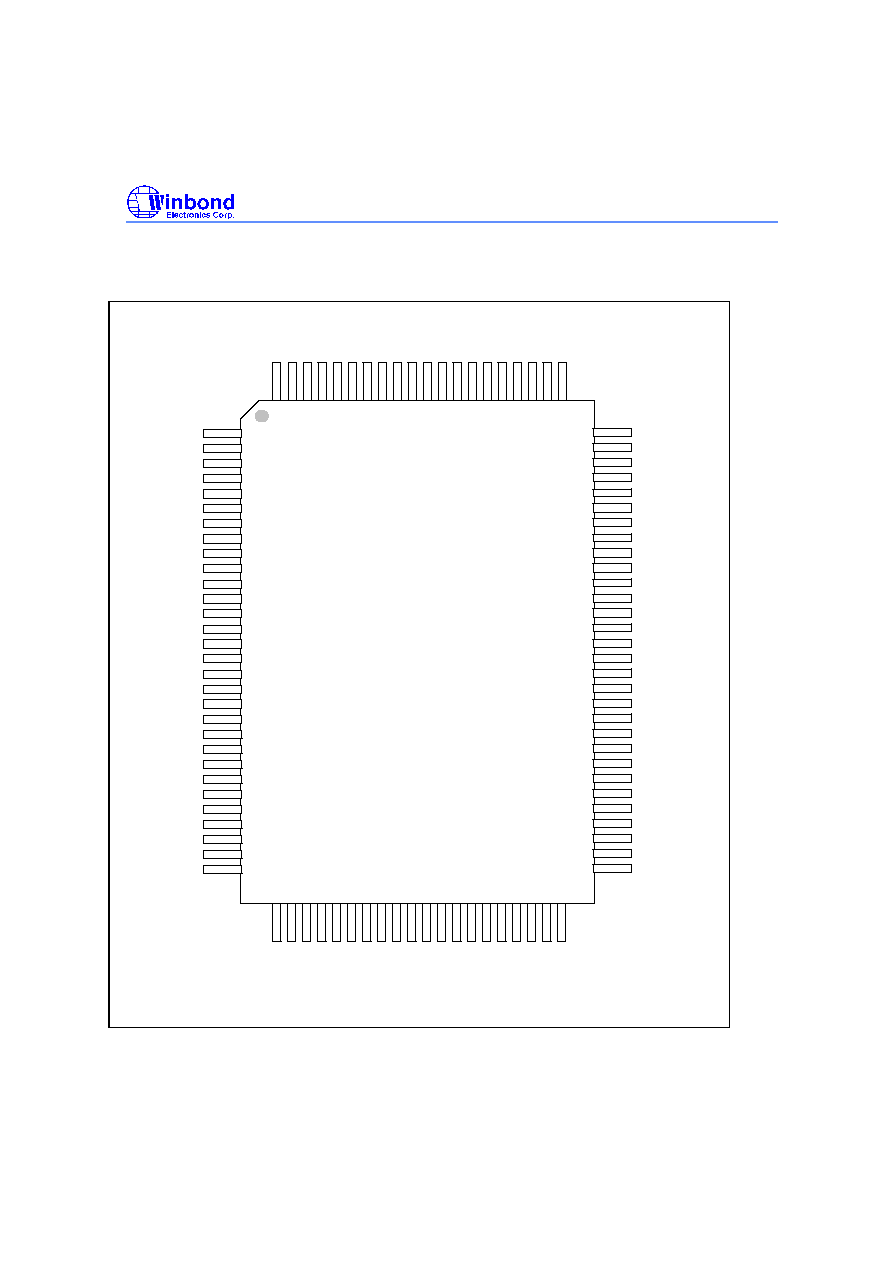
W742C818
Publication Release Date: October 2000
- 5 - Revision A2
3. PIN CONFIGURATION
W742C818
4
5
6
7
8
9
10
11
12
13
14
15
16
17
1
2
3
18
19
9
7
8
9
0
1
2
3
4
5
6
7
8
9
20
21
22
23
24
0
1
2
3
3
3
3
4
5
3
3
3
6
3
7
8
3
3
9
0
4
51
52
53
54
55
56
57
58
59
60
61
62
63
64
0
6
5
25
26
27
28
29
30
4
1
2
3
4
5
6
7
8
9
4
4
4
4
4
4
4
4
5
65
66
67
68
69
70
71
72
73
74
75
76
77
78
79
80
1
2
3
4
8
8
8
8
8
8
8
8
8
9
9
9
9
9
9
9
9
9
1
0
NC
NC
NC
NC
NC
NC
VLCD5
VLCD3
VLCD2
CP
P01
P00
P11
P12
P13
NC
SEG02
SEG08
NC
NC
COM02
COM03
COM04
COM05
COM06
COM07
SEG00
S
E
G
1
5
S
E
G
1
4
S
E
G
1
3
S
E
G
1
2
X
I
N
1
X
O
U
T
1
R
C
0
R
C
1
R
C
3
R
D
0
VLCD4
R
C
2
S
E
G
1
8
S
E
G
1
7
VLCD1
CN
COM00
S
E
G
1
6
R
D
2
MFP
R
D
1
RA0
SEG07
S
E
G
1
1
100-PIN
COM01
NC
NC
RA2
RA3
RB0
RB1
RB2
RB3
XOUT2
XIN2
VSS
R
D
3
R
E
0
R
E
1
R
E
2
R
E
3
R
F
0
R
F
1
R
F
2
R
F
3
/
R
E
S
E
T
V
D
D
P02
P03
P10
SEG01
SEG03
SEG04
SEG05
SEG06
SEG09
SEG10
S
E
G
1
9
S
E
G
2
0
S
E
G
2
1
S
E
G
2
2
S
E
G
2
3
S
E
G
2
4
S
E
G
2
7
N
C
S
E
G
2
5
S
E
G
2
6
QFP
RA1
DTMF
[Data_IO]
[Vpp]
[mode]
NC
NC
N
C
N
C
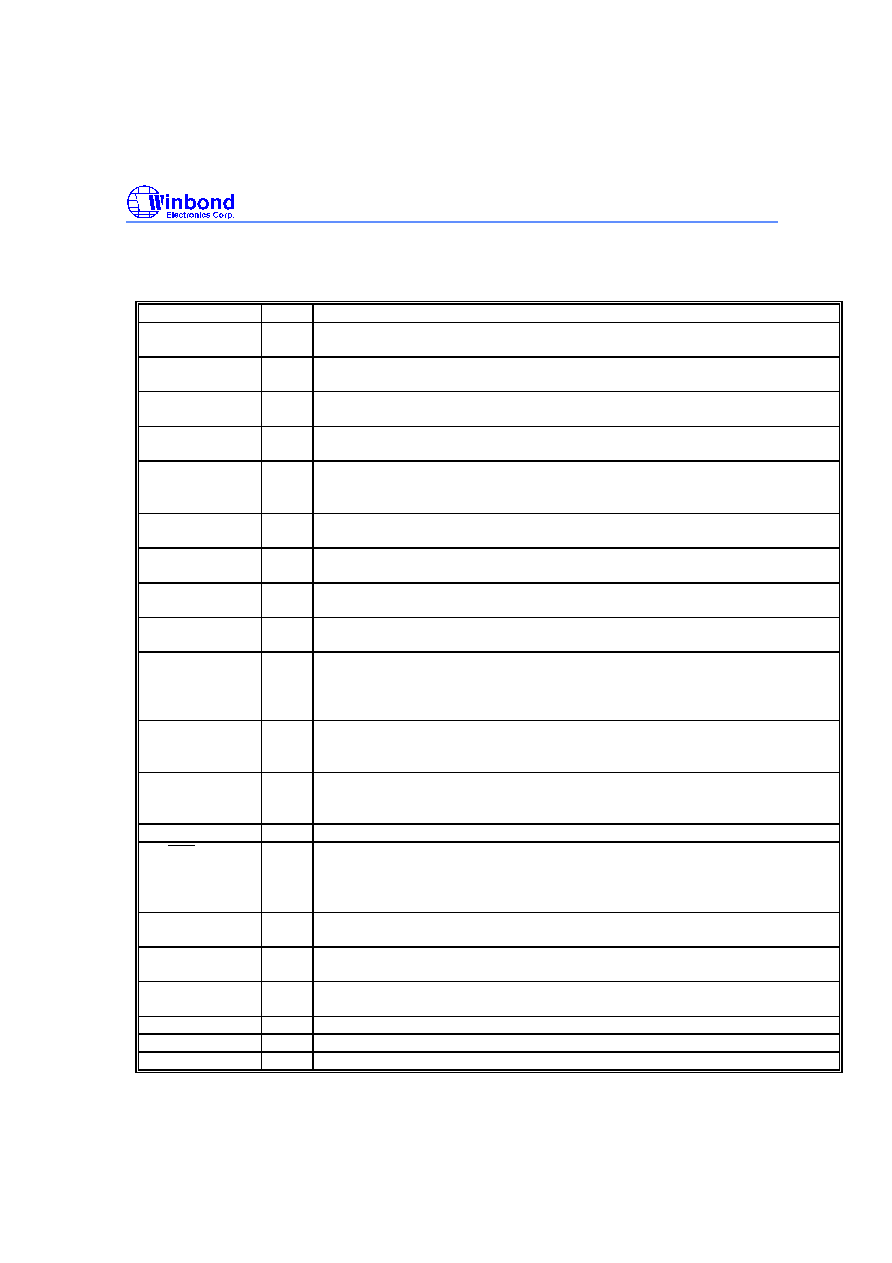
W742C818
Publication Release Date: October 2000
- 6 - Revision A2
4. W742C818 PIN DESCRIPTION
SYMBOL
I/O
FUNCTION
XIN2
I
Input pin for sub-oscillator.
Connected to 32.768 Khz crystal only.
XOUT2
O
Output pin for sub-oscillator with internal oscillation capacitor. Connected to
32.768 Khz crystal only.
XIN1
I
Input pin for main-oscillator.
Connected to 3.58MHz crystal or resistor to generate system clock.
XOUT1
O
Output pin for main-oscillator.
Connected to 3.58MHz crystal or resistor to generate system clock.
RA0-RA3
Data_IO
I/O
Input/Output port.
Input/output mode specified by port mode 1 register (PM1).
RA.3: serial data Input/Output for electrical erasable EPROM type
RB0-RB3
I/O
Input/Output port.
Input/output mode specified by port mode 2 register (PM2).
RC0-RC3
I
Input port only.
Each pin has an independent interrupt capability.
RD0-RD3
I
Input port only.
This port can release hold mode but can not occur interrupt service routine.
RE0-RE3
RF0-RF3
O
Output port only. CMOS type with high sink current capacity for the LED
application.
P00-P03
I/O
Input/Output port.
Input/output mode specified by port mode 6 register (PM6).
P0.0 and P0.1 can be a serial I/O interface selected by SIR register. P0.0
indicates serial clock, P0.1indicates serial data.
P10-P13
Mode
I
Input port only.
P1.2 & P1.3 indicates hardware interrupt(/INT0 & /INT1)
P1.3: Mode select for electrical erasable EPROM type
MFP
O
Output pin only, default in low state.
This pin can output modulating or non-modulating frequency, or Timer 1
clock output specified by mode register 1 (MR1).
DTMF
O
This pin can output dual-tone multi-frequency signal for dialing.
RES
Vpp
I
System reset pin with internal pull-high resistor.
Vpp : Supply programming voltage, without internal pull-high resistor
for electrical erasable EPROM type for avoiding high voltage
programming damage
SEG0-
SEG27
O
LCD segment output pins.
COM0-
COM7
O
LCD common signal output pins.
The LCD alternating frequency can be selected by code option.
CP,CN
I
Connection terminals for LCD voltage doubler capacitor(0.1uF), tuning the
capacitor value can reduce the LCD driving current .
VLCD1-5
I
Positive LCD voltage supply terminals.
VDD
I
Positive power supply (+).
VSS
I
Negative power supply (-).
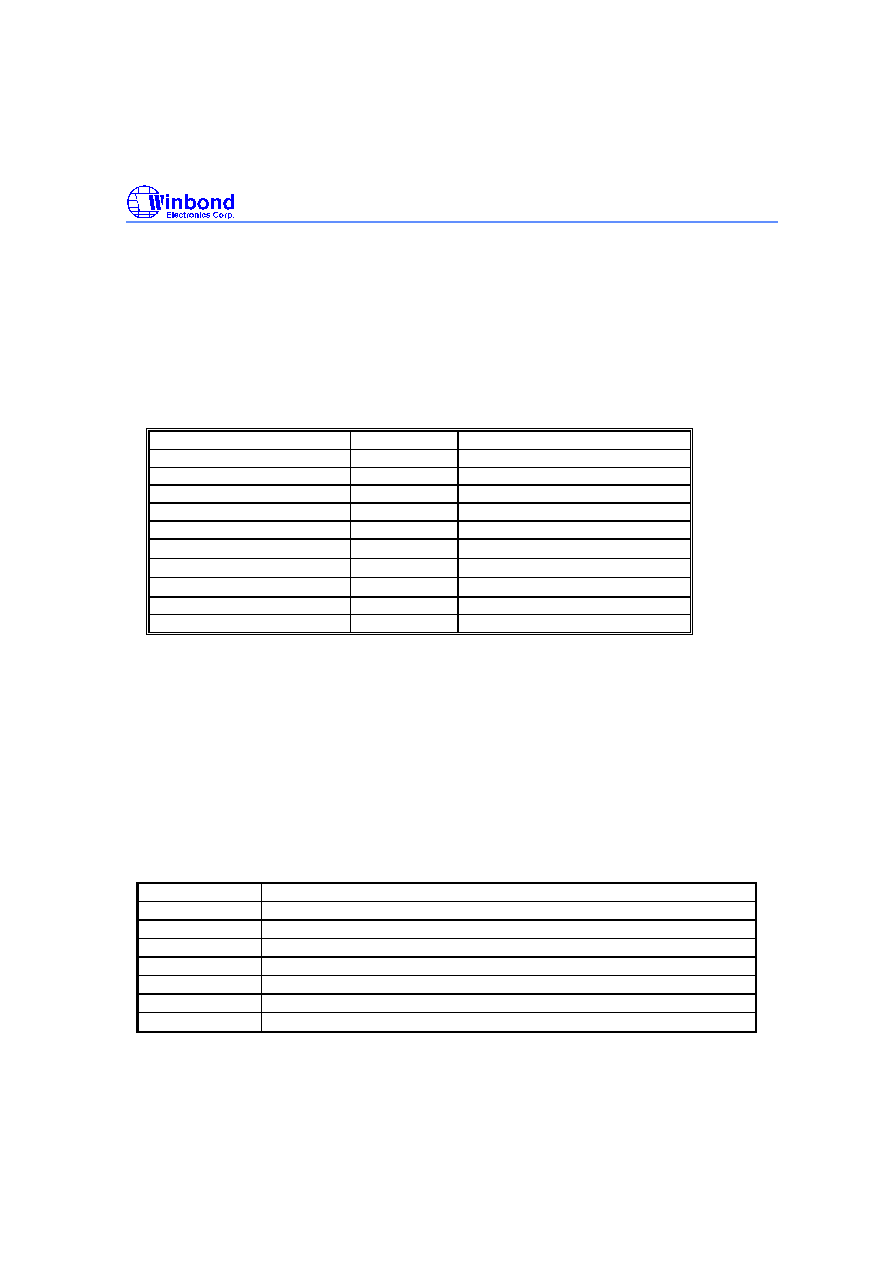
W742C818
Publication Release Date: October 2000
- 7 - Revision A2
5. FUNCTIONAL DESCRIPTION
5.1 Program Counter (PC)
Organized as an 14-bit binary counter (PC0 to PC13), the program counter generates the
addresses of the 16384 (16K)
�
16 on-chip ROM containing the program instruction words.
When the interrupt or initial reset conditions are to be executed, the corresponding address
will be loaded into the program counter directly. From address 0000h to 0023h are reserved
for reset and interrupt service routine. The format used is shown below.
ITEM
ADDRESS
INTERRUPT PRIORITY
Initial Reset
0000H
-
INT 0 (Divider0)
0004H
1st
INT 1 (Timer 0)
0008H
2nd
INT 2 (Port RC)
000CH
3rd
INT 3 (Port 1.2(/INT0))
0010H
4th
INT 4 (Divider1)
0014H
5th
INT 5 (Serial I/O)
0018H
6th
INT 6 (Port1.3(/INT1))
001CH
7th
INT 7 (Timer 1)
0020H
8th
code start
0024H
-
Table 1 Vector address and interrupt priority
5.2 Stack Register (STACK)
The stack register is organized as 51 bits x 16 levels (first-in, last-out). When either a call
subroutine or an interrupt is executed, the program
counter(PC) ,TAB0 ,TAB1 ,TAB2 ,TAB3 ,DBKRL ,DBKRH ,WRP ,ROMPR ,PAGE ,ACC and
CF will be pushed into the stack register automatically. At the end of a call subroutine or an
interrupt service subroutine, the RTN (only restore the program counter) and RTN #I instruction
could pop the contents of the stack register into the corresponding registers. It can restore part
of contents of stack buffer. When the stack register is pushed over the 16th level, the contents
of the first level will be overwritten. In the other words, the stack register is always 16 levels
deep. The bit definition of #I is listed below.
I=0000 0000
Pop PC from stack only
bit0=1
Pop TAB0, TAB1, TAB2, TAB3 from stack
bit1=1
Pop DBKRL, DBKRH from stack
bit2=1
Pop WRP from stack
bit3=1
Pop ROMPR from stack
bit4=1
Pop PAGE from stack
bit5=1
Pop ACC from stack
bit6=1
Pop CF from stack
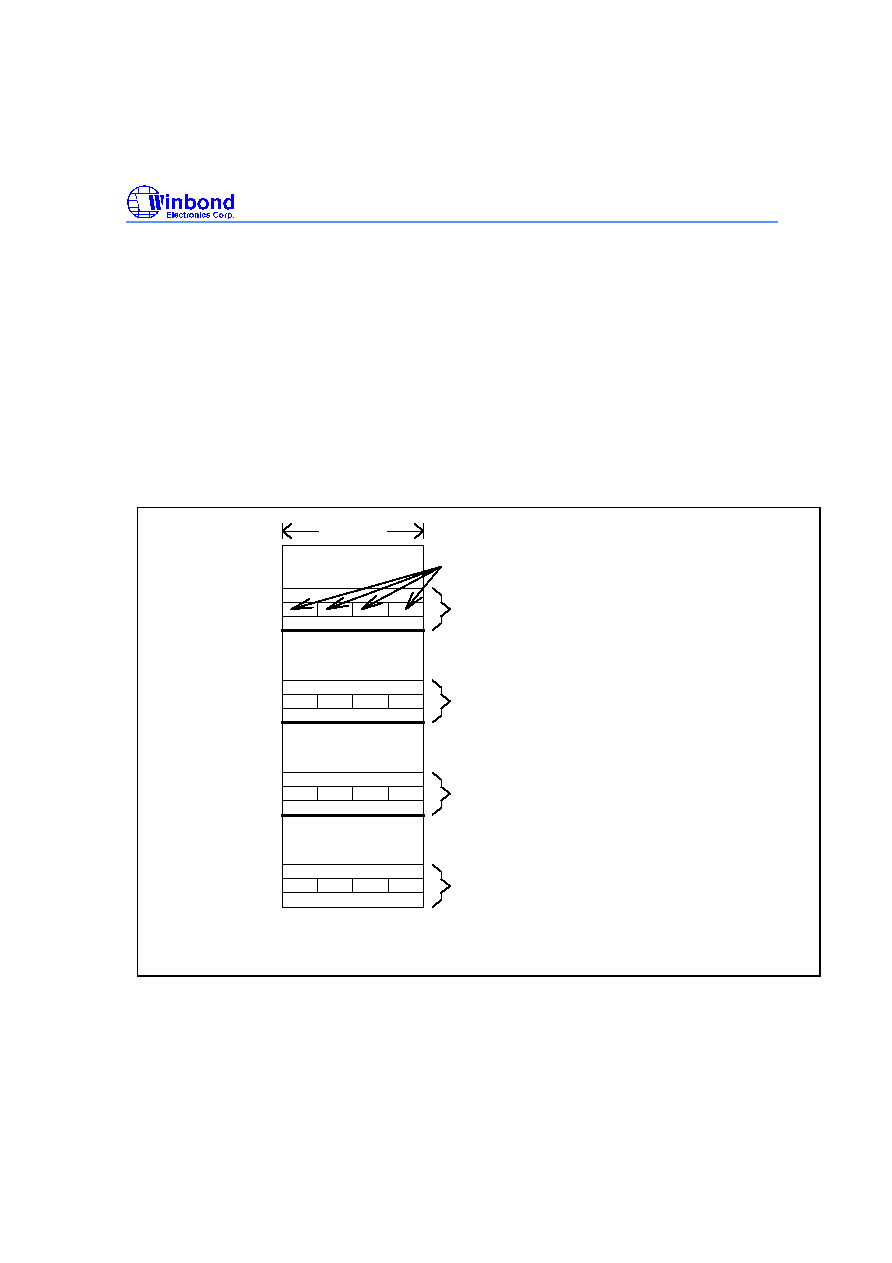
W742C818
Publication Release Date: October 2000
- 8 - Revision A2
5.3 Program Memory (ROM)
The read-only memory (ROM) is used to store program codes or the look-up table that can be
arranged up to 65536(64K)
�
4 bits. The program ROM is divided into eight pages; the size of
each page is 2048(2K)
�
16 bits. So the total ROM size is 16384(16K)
�
16 bits. Before the jump
or subroutine call instructions are to be executed, the destination ROM page register (ROMPR)
must be determined firstly. The ROM page can be selected by executing the MOV ROMPR, #I
or MOV ROMPR,RAM instructions. But the branch decision instructions (e.g. JB0, SKB0, JZ,
JC, ...) must jump into the same ROM page. Each look-up table element is composed of 4 bits,
so the look-up table can be addressed up to 65536(64K) elements. It uses instructions MOV
TAB0,R MOV TAB1,R MOV TAB2,R MOV TAB3,R to determine the look-up table element
address. The look-up table address is 4 times PC counter. Instruction MOVC R is used to read
the look-up table content and save data into the RAM. The organization of the program
memory is shown in Figure 5-1.
0000
H
16 bits
16384 * 16 bits
0FFFH
0800H
:
:
Each element (4 bits) of the look-up table
:
07FFH
:
1000H
1FFFH
1800H
:
:
:
17FFH
:
2000H
2FFFH
2800H
:
:
:
27FFH
:
3800H
:
:
37FFH
:
3000H
3FFFH
:
All Program memory can be used to store instruction code or look-up table
Page 0
Page 1
Page 2
Page 3
Page 4
Page 5
Page 6
Page 7
Figure 5-1 Program Memory Organization
5.3.1 ROM Page Register (ROMPR)
The ROM page register is organized as a 4-bit binary register. The bit descriptions are as follows:

W742C818
Publication Release Date: October 2000
- 9 - Revision A2
0
1
2
3
ROMPR
R/W
R/W
R/W
Note: W means write only.
Bit 3 is reserved.
Bit 2, Bit 1, Bit 0 ROM page bits:
0000 = ROM page 0 (0000H - 07FFH)
0001 = ROM page 1 (0800H - 0FFFH)
0010 = ROM page 2 (1000H - 17FFH)
0011 = ROM page 3 (1800H - 1FFFH)
0100 = ROM page 4 (2000H - 27FFH)
0101 = ROM page 5 (2800H - 2FFFH)
0110 = ROM page 6 (3000H - 37FFH)
0111 = ROM page 7 (3800H - 3FFFH)
5.3.2 ROM Addressing Mode
1. Direct Addressing
Bit 13-0 13 12 11 10 9 8 7 6 5 4 3 2 1 0
A13 A12 A11 A10 A9 A8 A7 A6 A5 A4 A3 A2 A1 A0
PC
2. Far Jump or Call
Bit 13-0 13 12 11 10 9 8 7 6 5 4 3 2 1 0
P2 P1 P0 A10 A9 A8 A7 A6 A5 A4 A3 A2 A1 A0
PC
P0-2 is ROM page register(ROMPR)
Example:
MOV ROMPR,#I
JMP Label_A
or
MOV ROMPR,#I
CALL SUB_A
3. Conditional JMP

W742C818
Publication Release Date: October 2000
- 10 - Revision A2
Bit 13-0 13 12 11 10 9 8 7 6 5 4 3 2 1 0
0 0 0 A10 A9 A8 A7 A6 A5 A4 A3 A2 A1 A0
PC
jmp into the same page
Example:
JB0 Lable_A0
JB1 Lable_A1
JB2 Lable_A2
JB3 Lable_A3
JZ Label_Az
JNZ Label_Anz
JC Label_Ac
JNC Label_Anc
4. Look-up Table
Bit 15-0 15 14 13 12 11 10 9 8 7 6 5 4 3 2 1 0
TA33 TA32 TA31 TA30 TA23 TA22 TA21 TA20 TA13 TA12 TA11 TA10 TA03 TA02 TA01 TA00
Table address
Look-up table address = (TAB3, TAB2, TAB1, TAB0)
Example:
TABLE TAB_addr ; Real_TAB_addr (PC value) = TAB_addr/4
00h, 01h, 02h, 0Ah, 0Ch, 0Dh, 0Eh, 0Fh
ENDT
MOV TAB0, TAB_addr_B0_3 ;set Look-up table address
MOV TAB1, TAB_addr_B4_7
MOV TAB2, TAB_addr_B8_11
MOV TAB3, TAB_addr_B12_15
MOVC RAM ;get Look-up table value to RAM
5.4 Data Memory (RAM)
5.4.1 Architecture
The static data memory (RAM) used to store data is arranged up to 4096(4K)
�
4 bits. The data
RAM is divided into 32 banks; each bank has 128
�
4 bits. Executing the MOV DBKRL,WR,
MOV DBKRH,WR or MOV DBKRL,#I, MOV DBKRH,#I instructions can determine which data
bank is used. The data memory can be accessed directly or indirectly and the data bank
register has to be confirmed firstly. In the indirect addressing mode, each data bank will be
divided into eight pages. The RAM page register has to be setting when in the indirect
accessing RAM. The instructions MOV WRn,@WRq MOV @WRq,WRn could Read or Write

W742C818
Publication Release Date: October 2000
- 11 - Revision A2
the whole memory in the indirect addressing mode. The RAM address of @WRq indicates to
(DBKRH)*800H + (DBKRL)*80H + (RAM page)*10H + (WRq). The organization of the data
memory is shown in Figure 5-2.
data bank 00
4096
address
0000H
4 bits
4096 * 4 bits
:
007FH
0080H
:
00FFH
data bank 01
:
:
:
0F80H
:
0FFFH
data bank 31
(or Working Registers bank)
00H
:
0FH
10H
:
1FH
20H
:
2FH
70H
:
7FH
:
:
1st data RAM page
(or 1st WR page)
2nd data RAM page
(or 2nd WR page)
8th data RAM page
(or 8th WR page)
3rd data RAM page
(or 3rd WR page)
(or Working Registers bank)
Figure 5-2 Data Memory Organization
The 1st and 2nd data bank (00H to 7FH & 80H to 0FFH) in the data memory can also be used
as the working registers (WR). It is also divided into sixteen pages. Each page contains 16
working registers. When one page is used as Working Register, the others can be used as the
normal data memory. The WR page register can be switched by executing the MOV WRP,R or
MOV WRP,#I instructions. The data memory can not do the logical operation directly with the
immediate data, it has to via the Working Register.
5.4.2 RAM Page Register (PAGE)
The page register is organized as a 4-bit binary register. The bit descriptions are as follows:
R/W
R/W
R/W
0
1
2
3
PAGE
Note: R/W means read/write available.
Bit 3 is reserved.
Bit 2, Bit 1, Bit 0 RAM page bits:
000 = Page 0 (00H - 0FH)
001 = Page 1 (10H - 1FH)
010 = Page 2 (20H - 2FH)
011 = Page 3 (30H - 3FH)
100 = Page 4 (40H - 4FH)
101 = Page 5 (50H - 5FH)
110 = Page 6 (60H - 6FH)
111 = Page 7 (70H - 7FH)

W742C818
Publication Release Date: October 2000
- 12 - Revision A2
5.4.3 WR Page Register (WRP)
The WR page register is organized as a 4-bit binary register. The bit descriptions are as follows:
R/W
R/W
R/W
0
1
2
3
WRP
R/W
Note: R/W means read/write available.
Bit 3, Bit 2, Bit 1, Bit 0 Working registers page bits:
0000 = WR Page 0 (00H - 0FH)
0001 = WR Page 1 (10H - 1FH)
0010 = WR Page 2 (20H - 2FH)
0011 = WR Page 3 (30H - 3FH)
0100 = WR Page 4 (40H - 4FH)
0101 = WR Page 5 (50H - 5FH)
0110 = WR Page 6 (60H - 6FH)
0111 = WR Page 7 (70H - 7FH)
1000 = WR Page 8 (80H - 8FH)
1001 = WR Page 9 (90H - 9FH)
1010 = WR Page A (A0H - AFH)
1011 = WR Page B (B0H - BFH)
1100 = WR Page C (C0H - CFH)
1101 = WR Page D (D0H - DFH)
1110 = WR Page E (E0H - EFH)
1111 = WR Page F (F0H - FFH)
5.4.4 Data Bank Register (DBKRH, DBKRL)
The data bank register is organized as two 4-bit binary register. The bit descriptions are as follows:
R/W
R/W
R/W
0
1
2
3
DBKRL
R/W
R/W
0
1
2
3
DBKRH
Note: R/W means read/write available.
Bit5 must keep zero.
Bit5, Bit 4, Bit3, Bit 2, Bit 1, Bit 0 Data memory bank bits:
000000 = Data bank 0 (000H - 07FH)
000001 = Data bank 1 (080H - 0FFH)
000010 = Data bank 2 (100H - 17FH)

W742C818
Publication Release Date: October 2000
- 13 - Revision A2
000011 = Data bank 3 (180H - 1FFH)
000100 = Data bank 4 (200H - 27FH)
000101 = Data bank 5 (280H - 2FFH)
000110 = Data bank 6 (300H - 37FH)
000111 = Data bank 7 (380H - 3FFH)
001000 = Data bank 8 (400H - 47FH)
001001 = Data bank 9 (480H - 4FFH)
001010 = Data bank 10 (500H - 57FH)
001011 = Data bank 11 (580H - 5FFH)
001100 = Data bank 12 (600H - 67FH)
001101 = Data bank 13 (680H - 6FFH)
001110 = Data bank 14 (700H - 77FH)
001111 = Data bank 15 (780H - 7FFH)
010000 = Data bank 16 (800H - 87FH)
010001 = Data bank 17 (880H - 8FFH)
010010 = Data bank 18 (900H - 97FH)
010011 = Data bank 19 (980H - 9FFH)
010100 = Data bank 20 (0A00H - 0A7FH)
010101 = Data bank 21 (0A80H - 0AFFH)
010110 = Data bank 22 (0B00H - 0B7FH)
010111 = Data bank 23 (0B80H - 0BFFH)
011000 = Data bank 24 (0C00H - 0C7FH)
011001 = Data bank 25 (0C80H - 0CFFH)
011010 = Data bank 26 (0D00H - 0D7FH)
011011 = Data bank 27 (0D80H - 0DFFH)
011100 = Data bank 28 (0E00H - 0E7FH)
011101 = Data bank 29 (0E80H - 0EFFH)
011110 = Data bank 30 (0F00H - 0F7FH)
011111 = Data bank 31 (0F80H - 0FFFH)
5.4.5 RAM Addressing Mode
1. Direct Addressing
Bit 11-0 11 10 9 8 7 6 5 4 3 2 1 0
BH0 BL3 BL2 BL1 BL0 RA6 RA5 RA4 RA3 RA2 RA1 RA0
RAM addr
RA0-6 is RAM address ; BL0-3 is DBKRL register ; BH0 is DBKRH register
Example:
MOV DBKRL,#BL_value ;set RAM bank

W742C818
Publication Release Date: October 2000
- 14 - Revision A2
MOV DBKRH,#BH_value
MOV A,RAM ;get RAM data to ACC
2. Working register Addressing
Bit 7-0 7 6 5 4 3 2 1 0
WP3 WP2 WP1 WP0 WA3 WA2 WA1 WA0
RAM addr
WA0-3 is Working register address ; WP0-3 is WR page register(WRP)
Example:
MOV DBKRL,#BL_value ;set RAM bank
MOV DBKRH,#BH_value
MOV WRP,#I ;set WR page register
MOVA WRn,RAM ;mov RAM data to Working register and ACC
3. Indirect Addressing
Bit 12-0 11 10 9 8 7 6 5 4 3 2 1 0
BH0 BL3 BL2 BL1 BL0 DP2 DP1 DP0 (WA3 WA2 WA1 WA0)
RAM addr
(WA0-3) is Working register contents ; DP0-3 is RAM page register(PAGE)
BL0-3 is DBKRL register ; BH0 is DBKRH register
Example:
MOV DBKRL,BL_value ;set RAM bank
MOV DBKRH,BH_value
MOV PAGE,#Ip ;set RAM page address,(0-07H)
MOV WRq,#In ;set WR pointer address;(0-0FH)
MOV WRn,@WRq ;get the contents of WRq pointing addr to WRn
5.5 Accumulator (ACC)
The accumulator (ACC) is a 4-bit register used to hold results from the ALU and transfer data
between the memory, I/O ports, and registers.
5.6 Arithmetic and Logic Unit (ALU)
This is a circuit which performs arithmetic and logic operations. The ALU provides the following
functions:
�
Logic operations: ANL, XRL, ORL
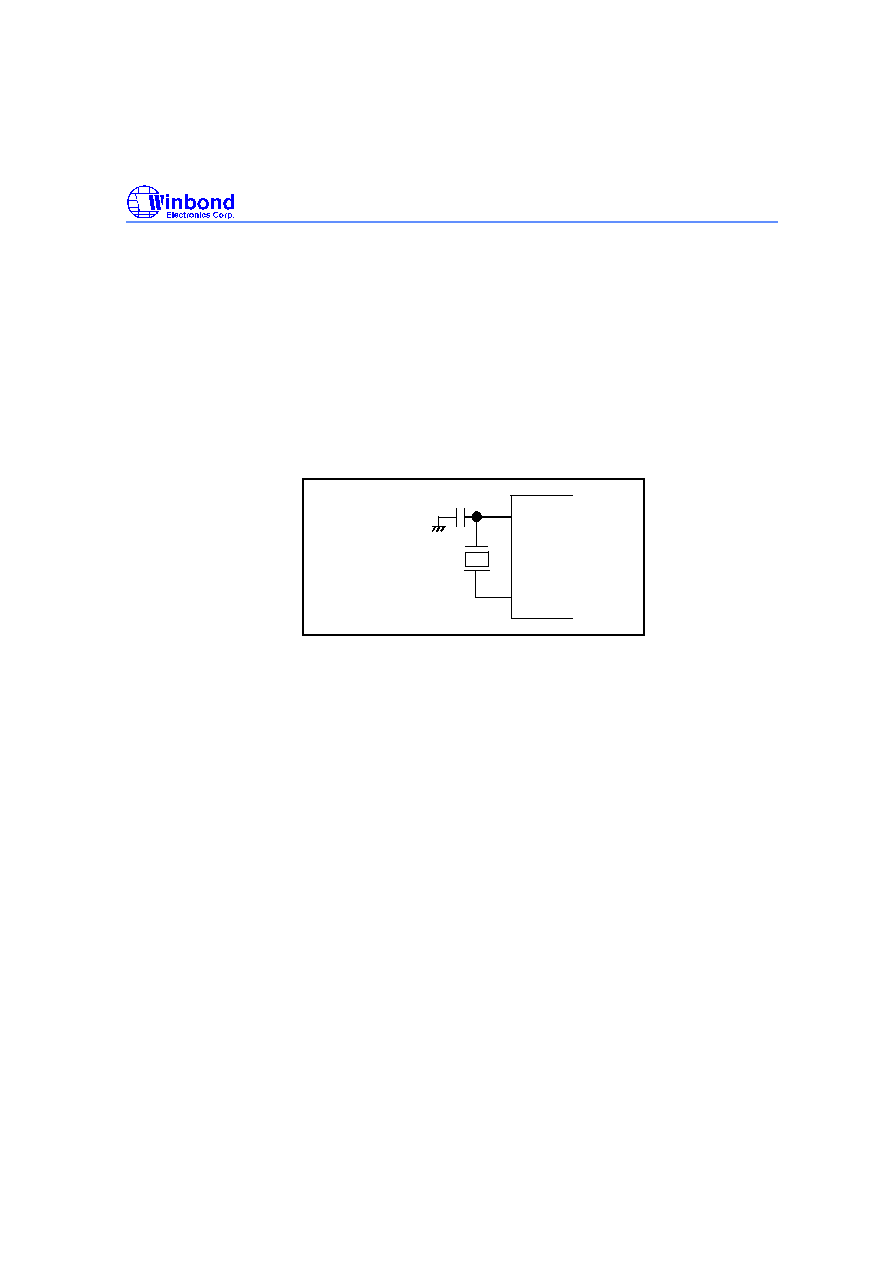
W742C818
Publication Release Date: October 2000
- 15 - Revision A2
�
Branch decisions: JB0, JB1, JB2, JB3, JNZ, JZ, JC, JNC, DSKZ, DSKNZ, SKB0, SKB1, SKB2,
SKB3
�
Shift operations: SHRC, RRC, SHLC, RLC
�
Binary additions/subtractions: ADC, SBC, ADD, SUB, ADU, DEC, INC
After any of the above instructions is executed, the status of the carry flag (CF) and zero flag (ZF)
is stored in the internal registers. CF can be read out by executing MOV R, CF.
5.7 Main Oscillator
The W742C818 provides a crystal oscillation circuit to generate the system clock through
external connections. The 3.58 Mhz or 400Khz crystal must be connected to XIN1 and
XOUT1, see Figure 5-3 and a capacitor must be connected to XIN1 and V
SS
if an accurate
frequency is needed.
XIN1
XOUT1
Crystal
3.58MHz
Figure 5-3 System clock oscillator Configuration
5.8 Sub-Oscillator
The sub-oscillator is used in dual-clock operation mode. In the sub-oscillator application, just
only the 32768 Hz crystal could be connected to XIN2 and XOUT2.
5.9 Dividers
Divider 0 is organized with a 14-bit binary up-counter that is designed to generate periodic
interrupt. When the main clock starts action, the Divider0 is incremented by each clock (F
OSC
).
The main clock can come from main oscillator or sub-oscillator by setting SCR register. When
an overflow occurs, the Divider0 event flag is set to 1 (EVF.0 = 1). Then, if the Divider0
interrupt enable flag has been set (IEF.0 = 1), the interrupt is executed, while if the hold
release enable flag has been set (HEF.0 = 1), the hold state is terminated. And the last 4-stage
of the Divider0 can be reset by executing CLR DIVR0 instruction. If the main clock is
connected to the 32.768K Hz crystal, the EVF.0 will be set to 1 periodically at the period of
500mS.
Divider 1 is organized with 13/12 bits up-counter that only has sub-oscillator clock source. If the
sub-oscillator starts action, the Divider1 is incremented by each clock (Fs). When an overflow
occurs, the Divider1 event flag is set to 1 (EVF.4 = 1). Then, if the Divider1 interrupt enable
flag has been set (IEF.4 = 1), the interrupt is executed, while if the hold release enable flag has
been set (HEF.4 = 1), the hold state is terminated. And the last 4-stage of the Divider1 can be
reset by executing CLR DIVR1 instruction. There are two period time (125mS & 250mS) that
can be selected by setting the SCR.3 bit. When SCR.3 = 0 (default), the 250mS period time is
selected; SCR.3 = 1, the 125 mS period time is selected.

W742C818
Publication Release Date: October 2000
- 16 - Revision A2
5.10 Dual-clock operation
In this dual-clock mode, the normal operation is performed by generating the system clock
from the main-oscillator clock (Fm). As required, the slow operation can be performed by
generating the system clock from the sub-oscillator clock (Fs). The exchange of the normal
operation and the slow operation is performed by setting the bit 0 of the System clock Control
Register (SCR). If the SCR.0 is set to 0, the clock source of the system clock generator is
main-oscillator clock; if the SCR.0 is set to 1, the clock source of the system clock generator is
sub-oscillator clock. In the dual-clock mode, the main-oscillator can stop oscillating when the
SCR.1 is set to 1. When the main clock switch, we must care the following cases:
1. X000B
X011B(Fosc=Fm
Fosc=Fs): we should not exchange the F
OSC
from Fm into Fs
and disable Fm simultaneously. We could first exchange the F
OSC
from Fm into Fs, then
disable the main-oscillator. So it should be X000B
X001B
X011B.
2. X011B
X000B(Fosc=Fs
Fosc=Fm): we should not enable Fm and exchange the F
OSC
from Fs into Fm simultaneously. We could first enable the main-oscillator; the 2nd step is
calling a delay subroutine to wait the main-oscillator oscillating stably; then exchange the F
OSC
from Fs into Fm is the last step. So it should be X011B
X001B
delay the Fm oscillating
stable time
X000B.
We must remember that the X010B state is inhibitive, because it will induce the system
shutdown.
The organization of the dual-clock operation mode is shown in Figure 5-4.

W742C818
Publication Release Date: October 2000
- 17 - Revision A2
System Clock
Generator
T1
T2
T3
T4
Main Oscillator
XIN1
XOUT1
Sub-oscillator
XIN2
XOUT2
Fosc
Divider 0
SCR : System clock Control Register ( default = 00H
)
Bit0
Bit1
Bit2
Bit3
0 : Fosc = Fm
1 : Fosc = Fs
0 : Fm enable
1 : Fm disable
0 : WDT input clock is Fosc/1024
1 : WDT input clock is Fosc/16384
Fm
Fs
enable/disable
SCR.1
STOP
HOLD
SCR.0
LCD Frequency
Selector
F
LCD
Divider 1
INT4
HCF.4
SCR.3(13/12 bit)
1 : 12 bit
0 : 13 bit
Daul clock operation mode :
- SCR.0=0, Fosc=Fm : SCR.0=1, Fosc=Fs
- Flcd=Fs, In STOP mode LCD is turned off.
Figure 5-4 Organization of the dual-clock operation mode
5.11 Watchdog Timer (WDT)
The watchdog timer (WDT) is organized as a 4-bit up counter designed to prevent the program
from unknown errors. The WDT can be enabled by mask option code. If the WDT overflows,
the chip will be reset. At initial reset, the input clock of the WDT is F
OSC
/1024. The input clock
of the WDT can be switched to F
OSC
/16384 by setting SCR.2 register. The contents of the
WDT can be reset by the instruction CLR WDT. In normal operation, the application program
must reset WDT before it overflows. A WDT overflow indicates that operation is not under
control and the chip will be reset. The WDT overflow period is about 500 mS when the system
clock (F
OSC
) is 32 KHz and WDT clock input is F
OSC
/1024. The organization of the Divider0
and watchdog timer is shown in Figure 5-5. The minimum WDT time interval is
1/(Fosc/16384x16) - 1/(Fosc/16384).
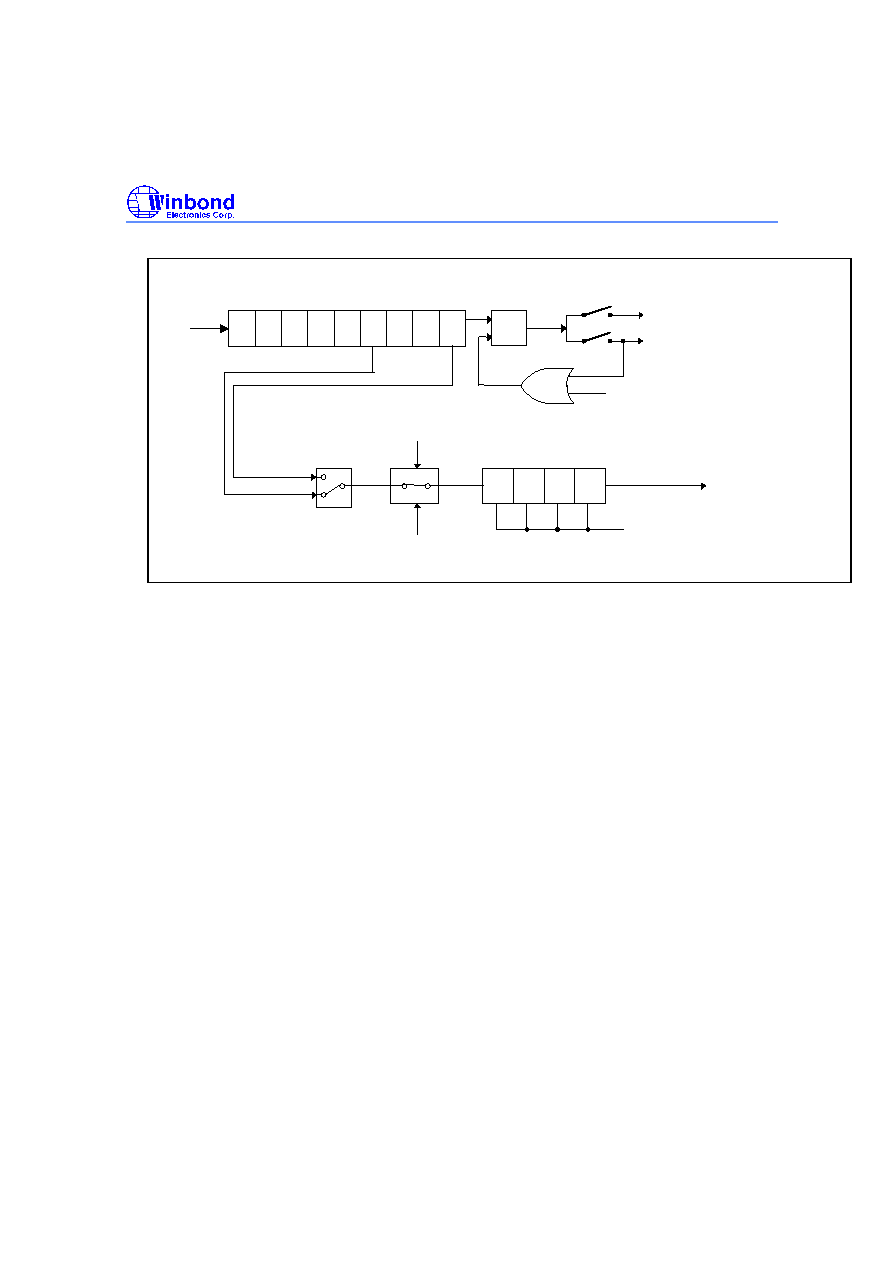
W742C818
Publication Release Date: October 2000
- 18 - Revision A2
Q1
Q2
Q9
Q10 Q11 Q12
Q14
Q13
Fosc
S
R
Q
HEF.0
IEF.0
1. Reset
2. CLR EVF,#01H
EVF.0
Hold mode release (HCF.0)
Divider interrupt
...
Overflow signal
WDT
Enable
Disable
SCR.2
Fosc/2048
Fosc/16384
Option code is reset to "0"
Qw1
Qw2
Qw4
Qw3
R
R
R
R
Divider0
System Reset
1. Reset
2. CLR WDT
3. CLR DIVR0
Option code is set to "1"
Figure 5-5 Organization of Divider0 and watchdog timer
5.12 Timer/Counter
5.12.1 Timer 0 (TM0)
Timer 0 (TM0) is a programmable 8-bit binary down-counter. The specified value can be
loaded into TM0 by executing the MOV TM0L(TM0H),R instructions. When the MOV
TM0L(TM0H),R instructions are executed, it will stop the TM0 down-counting (if the TM0 is
down-counting) and reset the start bit (MR0.3) to 0, and the specified value is loaded into TM0.
Then we can set MR0.3 to 1 to cause the event flag 1 (EVF.1) is reset and the TM0 starts to
down count. When it decrements to FFH from 00H, Timer 0 stops down-counting and
generates an underflow flag (EVF.1 = 1). Then, if the Timer 0 interrupt enable flag has been
set (IEF.1 = 1), the interrupt is executed, while if the hold release enable flag 1 has been set
(HEF.1 = 1), the hold state is terminated. The Timer 0 clock input can be set as F
OSC
/1024 or
F
OSC
/4 by setting MR0 bit 0. The default timer value is F
OSC
/4. The organization of Timer 0 is
shown in Figure 5-6.
If the Timer 0 clock input is F
OSC
/4:
Desired Timer 0 interval = (preset value +1)
�
4
�
1/F
OSC
If the Timer 0 clock input is F
OSC
/1024:
Desired Timer 0 interval = (preset value +1)
�
1024
�
1/F
OSC
Preset value: Decimal number of Timer 0 preset value
F
OSC
: Clock oscillation frequency
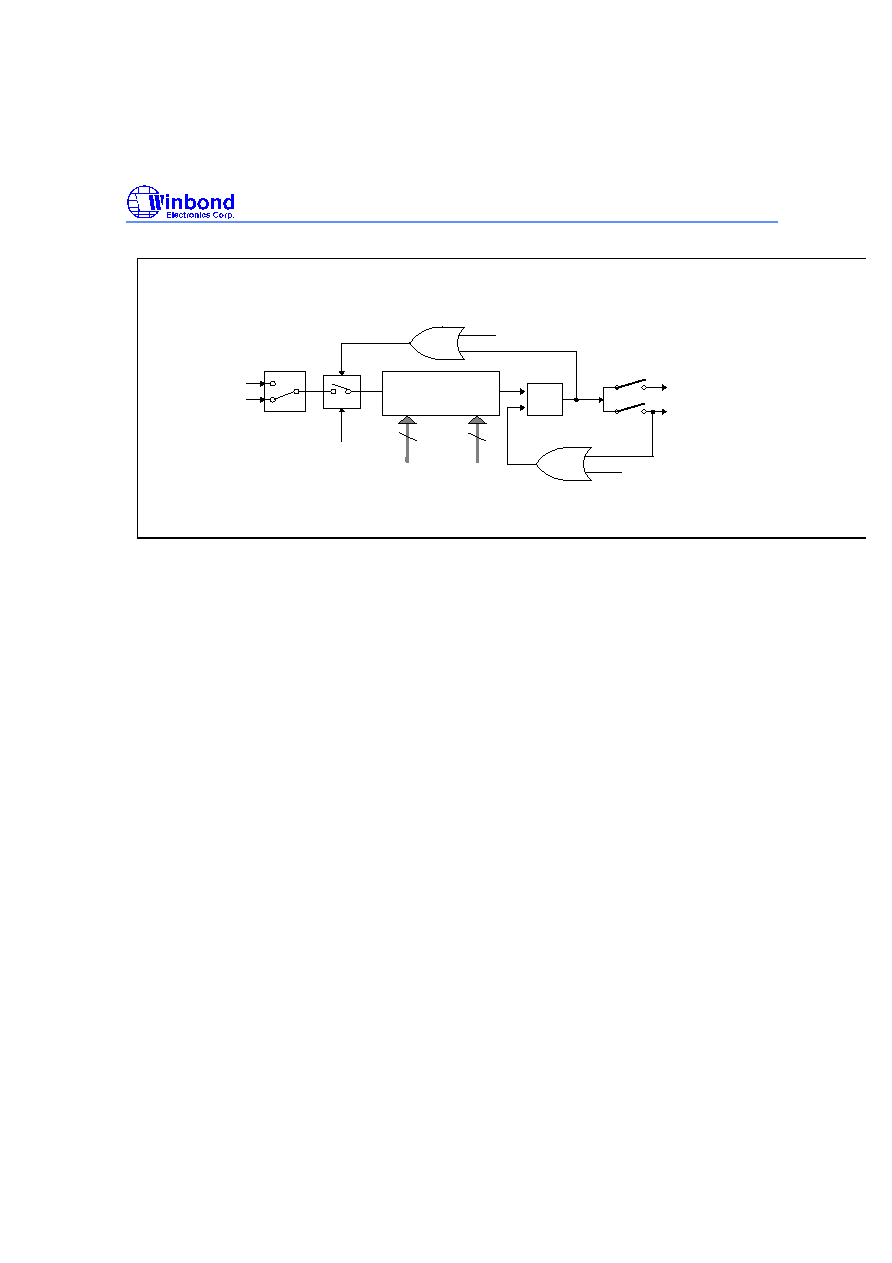
W742C818
Publication Release Date: October 2000
- 19 - Revision A2
Fosc/4
Fosc/1024
Enable
Disable
1. Reset
2. CLR EVF,#02H
8-Bit Binary
Down Counter
S
R
Q
HEF.1
IEF.1
Hold mode release (HCF.1)
Timer 0 interrupt (INT1)
1. Reset
2. CLR EVF,#02H
EVF.1
MR0.0
(Timer 0)
Set MR0.3 to 1
3. Reset MR0.3 to 0
3.Set MR0.3 to 1
4
4
MOV TM0H,R
MOV TM0L,R
4.MOV TM0L,R or MOV TM0H,R
Figure 5-6 Organization of Timer 0
5.12.2 Timer 1 (TM1)
Timer 1 (TM1) is also a programmable 8-bit binary down counter, as shown in Figure 5-7.
Timer 1 can output an arbitrary frequency to the MFP pin. The input clock of Timer 1 can be
one of three sources: F
OSC
/64, F
OSC
or F
S
. The source can be selected by setting bit 0 and bit
1 of mode register 1 (MR1). At initial reset, the Timer 1 clock input is F
OSC.
When the MOV
TM1L, R or MOV TM1H,R instruction is executed, the specified value is loaded into the auto-
reload buffer and the TM1 down-counting will be disabled that is the start bit (MR1.3) is reset to
0 simultaneously. If the bit 3 of MR1 is set (MR1.3 = 1), the content of the auto-reload buffer
will be loaded into the TM1 down counter, and Timer 1 starts to down count, and the event flag
7 is reset (EVF.7=0). When the timer decrements to 0FFH from 00H, it will generate an
underflow (EVF.7 = 1) and auto-reload the specified data then continue to count down. When
Timer1 underflows, if interrupt enable flag 7 has been set to 1 (IEF.7 = 1), an interrupt is
executed; if hold mode release enable flag 7 is set to 1 (HEF.7 = 1), the hold state is
terminated. The specified frequency of Timer 1 can be delivered to the MFP output pin by
programming bit 2 of MR1. Bit 3 of MR1 can be used to make Timer 1 stop or start counting.
In a case where Timer 1 clock input is F
T
:
Desired Timer 1 interval = (preset value +1) / F
T
Desired frequency for MFP output pin = F
T
�
(preset value + 1)
�
2 (Hz)
Preset value: Decimal number of Timer 1 preset value
F
OSC
: Clock oscillation frequency

W742C818
Publication Release Date: October 2000
- 20 - Revision A2
Auto-reload buffer
8 bits
MR1.3
Underflow signal
EVF.7
MFP
MFP signal
MR1.2
output pin
8-Bit Binary
Down Counter
2
circuit
Reset
Reset
Disable
Enable
Fosc/64
Fosc
MR1.0
(Timer 1)
S
R
Q
1. Reset
2. INT7 accept
3. CLR EVF, #80H
T
F
MOV TM1L,R or MOV TM1H,R
4. Set MR1.3 to 1
4
4
MOV TM1H,R
MOV TM1L,R
Set MR1.3 to 1
MR1.1
Fs
Figure 5-7 Organization of Timer 1
For example, when F
T
equals 32768 Hz, depending on the preset value of TM1, the MFP pin
will output a single tone signal in the tone frequency range from 64 Hz to 16384 Hz. The
relation between the tone frequency and the preset value of TM1 is shown in the table below.
C
C
#
B
G
F
E
D
A
#
#
D
#
#
G
F
A
E
N
O
T
TM1 preset value
& MFP frequency
3rd octave
4th octave
5th octave
261.63
277.18
293.66
311.13
329.63
349.23
369.99
392.00
415.30
440.00
466.16
493.88
523.25
554.37
587.33
622.25
659.26
698.46
739.99
783.99
830.61
880.00
932.23
987.77
260.06
277.69
292.57
309.13
327.68
348.58
372.35
390.08
420.10
442.81
3EH
3AH
37H
34H
31H
2EH
2BH
29H
26H
22H
24H
20H
468.11
496.48
1EH
1CH
1BH
19H
18H
16H
15H
14H
13H
12H
11H
10H
528.51
564.96
585.14
630.15
655.36
712.34
744.72
780.19
819.20
862.84
910.22
963.76
130.81
138.59
146.83
155.56
164.81
174.61
185.00
196.00
207.65
220.00
233.08
246.94
7CH
75H
6FH
68H
62H
5DH
58H
53H
4EH
45H
49H
41H
131.07
138.84
146.28
156.03
165.49
174.30
184.09
195.04
207.39
221.40
234.05
248.24
Tone
frequency
Tone
frequency
TM1 preset value
& MFP frequency
Tone
frequency
TM1 preset value
& MFP frequency
Note: Central tone is A4 (440 Hz).
Table 2 The relation between the tone frequency and the preset value of TM1

W742C818
Publication Release Date: October 2000
- 21 - Revision A2
5.12.3 Mode Register 0 (MR0)
Mode Register 0 is organized as a 4-bit binary register (MR0.0 to MR0.3). MR0 can be used to
control the operation of Timer 0. The bit descriptions are as follows:
W
W
0
1
2
3
MR0
Note: W means write only.
Bit 0 = 0 The fundamental frequency of Timer 0 is F
OSC
/4.
= 1 The fundamental frequency of Timer 0 is F
OSC
/1024.
Bit 1 & Bit 2 are reserved
Bit 3 = 0 Timer 0 stops down-counting.
= 1 Timer 0 starts down-counting.
5.12.4 Mode Register 1 (MR1)
Mode Register 1 is organized as a 4-bit binary register (MR1.0 to MR1.3). MR1 can be used to
control the operation of Timer 1. The bit descriptions are as follows:
W
W
W
W
0
1
2
3
MR1
Note: W means write only.
Bit 0 = 0 The internal fundamental frequency of Timer 1 is F
OSC
.
= 1 The internal fundamental frequency of Timer 1 is F
OSC
/64.
Bit 1 = 0 The fundamental frequency source of Timer1 is the internal clock.
= 0 The fundamental frequency source of Timer1 is the sub-oscillator frequency
Fs(32.768KHz).
Bit 2 = 0 The specified waveform of the MFP generator is delivered at the MFP output pin.
= 1 The specified frequency of Timer 1 is delivered at the MFP output pin.
Bit 3 = 0 Timer 1 stops down-counting.
= 1 Timer 1 starts down-counting.
5.13 Interrupts
The W742C818 provides four internal interrupt sources (Divider 0, Divider 1, Timer 0, Timer 1)
and seven external interrupt source (port P1.2(/INT 0), RC.0-3, Serial port, P1.3(/INT1)).
Vector addresses for each of the interrupts are located in the range of program memory (ROM)
addresses 004H to 023H. The flags IEF, PEF, and EVF are used to control the interrupts.
When EVF is set to "1" by hardware and the corresponding bits of IEF and PEF have been set
by software, an interrupt is generated. When PC jumps to an interrupt vector by interrupt
event, the corresponding bit of EVF will be clear, and all of the interrupts will be
inhibited until the EN INT or MOV IEF,#I instruction is invoked. Normally, the EN INT
instruction will be asserted before the RTN instruction. The interrupts can also be disabled
by executing the DIS INT instruction. When an interrupt is generated in the hold mode, the
hold mode will be released momentarily and interrupt service routine will be executed. After

W742C818
Publication Release Date: October 2000
- 22 - Revision A2
executing interrupt service routine, the
�
C will enter hold mode automatically. The operation
flow chart is shown in Figure 5-9. The control diagram is shown Figure 5-8.
S
R
Q
S
R
Q
S
R
Q
IEF.0
IEF.1
Interrupt
Process
Circuit
Interrupt
Vector
Generator
004H
008H
020H
IEF.2
Initial Reset
CLR EVF,#I instruction
DIS INT instruction
Initial Reset
MOV IEF,#I
Enable
EN INT
EVF.1
EVF.0
EVF.2
Disable
Divider 0
overflow signal
Timer 0
underflow signal
RC.0-3 signal
S
R
Q
IEF.3
EVF.3
P1.2 (/INT0) signal
S
R
Q
IEF.4
EVF.4
overflow signal
S
R
Q
IEF.5
EVF.5
Serial I/O signal
S
R
Q
IEF.6
EVF.6
P1.3(/INT1) signal
S
R
Q
IEF.7
EVF.7
underflow signal
Divider 1
Timer 1
Figure 5-8 Interrupt event control diagram

W742C818
Publication Release Date: October 2000
- 23 - Revision A2
5.14 Stop Mode Operation
In stop mode, all operations of the
�
C cease. The
�
C enters stop mode when the STOP
instruction is executed and exits stop mode when an external trigger is activated (by a falling
signal on the RC or RD port). When the designated signal is accepted, the
�
C awakens and
executes the next instruction. In the dual-clock slow operation mode, the STOP instruction will
disable both the main-oscillator and sub-oscillator oscillating; To avoid erroneous execution,
the NOP instruction should follow the STOP command.
5.14.1 Stop Mode Wake-up Enable Flag for RC and RD Port (SEF)
The stop mode wake-up flag for port RC and RD is organized as an 8-bit binary register (SEF.0
to SEF.7). Before port RC and RD can be used to exit the stop mode, the content of the SEF
must be set first. The SEF is controlled by the MOV SEF, #I instruction. The bit descriptions
are as follows:
SEF
w
w
w
4
5
6
w
7
w
w
w
0
1
2
w
3
Note: W means write only.
SEF.0 = 1 Device will exit stop mode when a falling edge signal is applied to pin RC.0
SEF.1 = 1 Device will exit stop mode when a falling edge signal is applied to pin RC.1
SEF.2 = 1 Device will exit stop mode when a falling edge signal is applied to pin RC.2
SEF.3 = 1 Device will exit stop mode when a falling edge signal is applied to pin RC.3
SEF.4 = 1 Device will exit stop mode when a falling edge signal is applied to pin RD.0
SEF.5 = 1 Device will exit stop mode when a falling edge signal is applied to pin RD.1
SEF.6 = 1 Device will exit stop mode when a falling edge signal is applied to pin RD.2
SEF.7 = 1 Device will exit stop mode when a falling edge signal is applied to pin RD.3
5.15 Hold Mode Operation
In hold mode, all operations of the
�
C cease, except for the operation of the oscillator, Timer,
Divider, and LCD driver. The
�
C enters hold mode when the HOLD instruction is executed.
The hold mode can be released in one of nine ways: by the action of timer 0, timer 1, divider 0,
divider 1, RC port, P1.2(/INT0), Serial I/O, P1.3(/INT1) and RD port. Before the device enters
the hold mode, the HEF,HEFD, PEF, and IEF flags must be set to control the hold mode
release conditions. When any of the HCF bits is "1," the hold mode will be released. Regarding
to RC and RD port, PSR0 and PSR1 registers indicate signal change on which pin of the port.
The HCF and HCFD are set by hardware and clear by software. When EVF,EVFD and
HEF,HEFD have been reset by the CLR EVF,#I CLR EVFD and MOV HEF,#I CLR HEFD
instructions, the corresponding bit of HCF,HCFD is reset simultaneously. The HCF and HCFD
should be clear every time before enter the hold mode. For more details, refer to the following
flow chart.
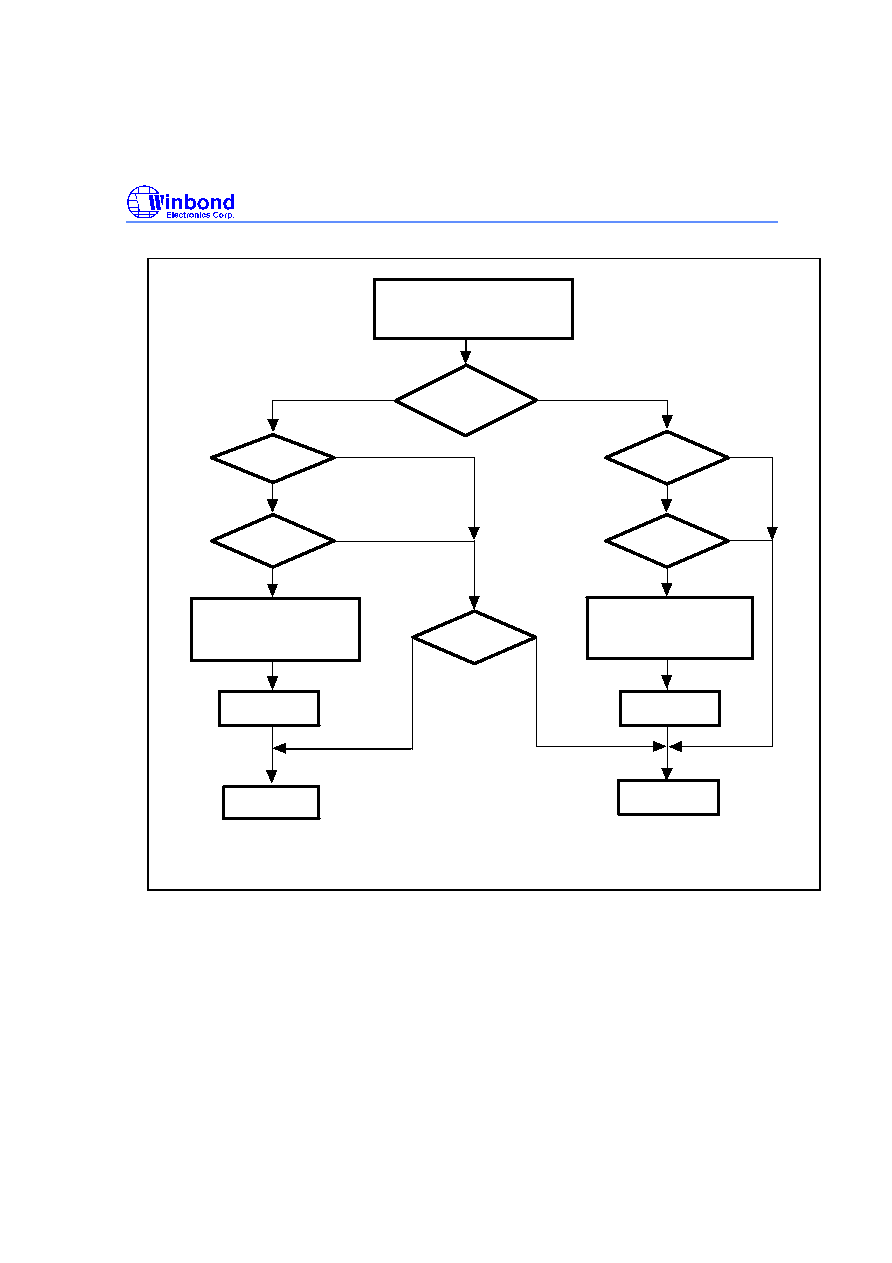
W742C818
Publication Release Date: October 2000
- 24 - Revision A2
Divider 0, Divider 1, Timer
0, Timer 1, Signal Change at
RC,RD port, falling edge at
P1.2, P1.3, Serial I/O
In
HOLD
Mode?
IEF
Flag Set?
PC <- (PC+1)
IEF
Flag Set?
No
Yes
No
Yes
Yes
No
Yes
No
HOLD
HEF
Flag Set?
Reset EVF Flag
Execute
Interrupt Service Routine
Reset EVF Flag
Execute
Interrupt Service Routine
Interrupt
Enable?
Interrupt
Enable?
Yes
Yes
No
No
Disable interrupt
Disable interrupt
(Note)
(Note)
Note: The bit of EVF corresponding to the interrupt signal will be reset.
** The RD port can not occur interrupt service , it only can release hold mode.
(Hold release)
Figure 5-9 Hold Mode and Interrupt Operation Flow Chart
5.15.1 Hold Mode Release Enable Flag (HEF,HEFD)
The hold mode release enable flag is organized on an 8-bit binary register (HEF.0 to HEF.7)
and a 1-bit register(HEFD). The HEF and HEFD are used to control the hold mode release
conditions. It is controlled by the MOV HEF, #I, MOV HEFD,#I instructions. The bit descriptions
are as follows:

W742C818
Publication Release Date: October 2000
- 25 - Revision A2
w
0
1
2
HEF
w
w
w
w
3
4
5
6
7
w
w
w
w
0
HEFD
Note: W means write only.
HEF.0 = 1 Overflow from the Divider 0 causes Hold mode to be released.
HEF.1 = 1 Underflow from Timer 0 causes Hold mode to be released.
HEF.2 = 1 Signal change at port RC causes Hold mode to be released.
HEF.3 = 1 Falling edge signal at port P1.2(/INT0) causes Hold mode to be released.
HEF.4 = 1 Overflow from the Divider 1 causes Hold mode to be released.
HEF.5 = 1 Serial I/O
HEF.6 = 1 Falling edge signal at port P1.3(/INT1) causes Hold mode to be released.
HEF.7 = 1 Underflow from Timer 1 causes Hold mode to be released.
HEFD = 1 Signal change at port RD causes Hold mode to be released.
5.15.2 Interrupt Enable Flag (IEF)
The interrupt enable flag is organized as a 8-bit binary register (IEF.0 to IEF.7). These bits are
used to control the interrupt conditions. It is controlled by the MOV IEF, #I instruction. When
one of these interrupts is occurred, the corresponding event flag will be clear, but the other bits
are unaffected. In interrupt subroutine, these interrupts will be disable till the instruction MOV
IEF, #I or EN INT is executed again. However, these interrupts can be disable by executing
DIS INT instruction. The bit descriptions are as follows:
w
1
2
3
IEF
4
w
w
5
6
0
w
w
7
w
w
w
Note: W means write only.
IEF.0 = 1 Interrupt 0 is accepted by overflow from the Divider 0.
IEF.1 = 1 Interrupt 1 is accepted by underflow from the Timer 0.
IEF.2 = 1 Interrupt 2 is accepted by a signal change at port RC.
IEF.3 = 1 Interrupt 3 is accepted by a falling edge signal at port P1.2(/INT0).
IEF.4 = 1 Interrupt 4 is accepted by overflow from the Divider 1.
IEF.5 = 1 Interrupt 5 is accepted by Serial I/O signal
IEF.6 = 1 Interrupt 6 is accepted by a falling edge signal at port P1.3(/INT1).
IEF.7 = 1 Interrupt 7 is accepted by underflow from Timer 1.
5.15.3 Port Enable Flag (PEF,P1EF)
The port enable flag is organized as 8-bit binary register (PEF.0 to PEF.7) and 4-bit register
(P1EF.2 and P1EF.3). Before port RC,RD may be used to release the hold mode , the content of
the PEF must be set first. The PEF and P1EF are controlled by the MOV PEF, #I MOV P1EF,#I
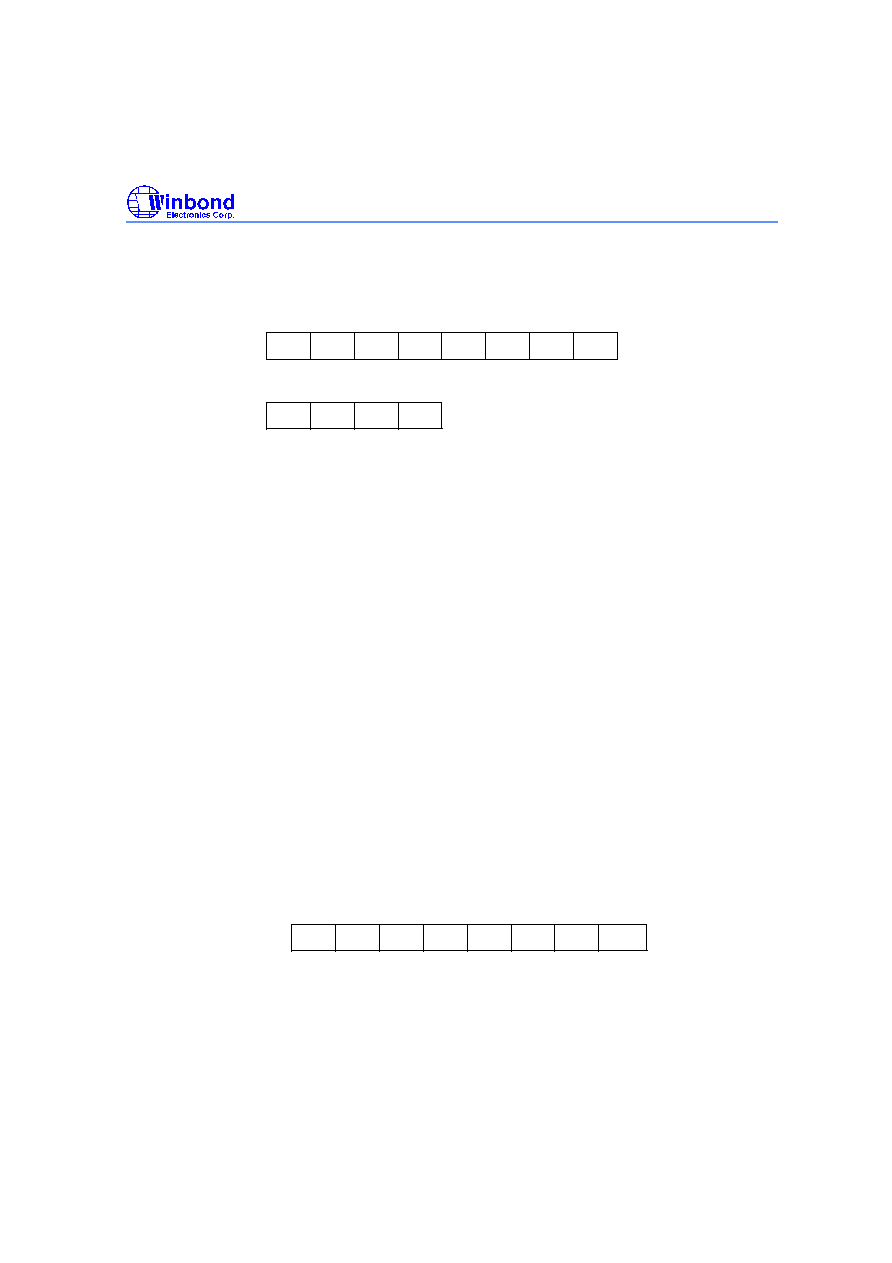
W742C818
Publication Release Date: October 2000
- 26 - Revision A2
instructions. The bit descriptions are as follows. Besides release hold mode, the RC port can be bit
controlled individually to perform interrupt function.
PEF
w
w
w
4
5
6
w
7
w
w
w
0
1
2
w
3
w
w
-
0
1
2
-
3
P1EF
Note: W means write only.
PEF.0: Enable/disable the signal change at pin RC.0 to release hold mode or perform interrupt.
PEF.1: Enable/disable the signal change at pin RC.1 to release hold mode or perform interrupt.
PEF.2: Enable/disable the signal change at pin RC.2 to release hold mode or perform interrupt.
PEF.3: Enable/disable the signal change at pin RC.3 to release hold mode or perform interrupt.
PEF.4: Enable/disable the signal change at pin RD.0 to release hold mode.
PEF.5: Enable/disable the signal change at pin RD.1 to release hold mode.
PEF.6: Enable/disable the signal change at pin RD.2 to release hold mode.
PEF.7: Enable/disable the signal change at pin RD.3 to release hold mode.
P1EF.2: Enable/disable the falling edge signal at P1.2 to release hold mode.
P1EF.3: Enable/disable the falling edge signal at P1.3 to release hold mode.
5.15.4 Hold Mode Release Condition Flag (HCF,HCFD)
The hold mode release condition flag is organized as 8-bit binary register (HCF.0 to HCF.7)and
HCFD. It indicates which one releases the hold mode, and is set by hardware. The HCF can be
read out by the MOVA R, HCFL and MOVA R, HCFH instructions. When any of the HCF bits is
"1," the hold mode will be released. But the HCFD can not be read, it is only for internal flag. It
records the port RD releases hold mode. The HCF and HCFD are set by hardware and cleared
when EVF or HEF are cleared. The HCF and HCFD should be clear every time before enter
the hold mode. When EVF, EVFD and HEF, HEFD have been reset, the corresponding bit of
HCF,HCFD is reset simultaneously. The bit descriptions are as follows:
R
R
HCF
0
1
2
3
4
5
R
R
R
6
7
R
R
R
HCFD: internal flag, can not be read
Note: R means read only.
HCF.0 = 1 Hold mode was released by overflow from the divider 0.
HCF.1 = 1 Hold mode was released by underflow from the timer 0.

W742C818
Publication Release Date: October 2000
- 27 - Revision A2
HCF.2 = 1 Hold mode was released by a signal change at port RC.
HCF.3 = 1 Hold mode was released by a signal change at port P1.2(/INT0).
HCF.4 = 1 Hold mode was released by overflow from the divider 1.
HCF.5 = 1 Hold mode was released by Serial I/O signal.
HCF.6 = 1 Hold mode was released by a signal change at port P1.3(/INT1).
HCF.7 = 1 Hold mode was released by underflow from the timer 1.
HCFD = 1 Hold mode was released by a signal change at port RD.
5.15.5 Event Flag (EVF,EVFD)
The event flag is organized as a 8-bit binary register (EVF.0 to EVF.7) and EVFD. It is set by
hardware and reset by CLR EVF,#I ,CLR EVFD instructions or the interrupt occurrence. The bit
descriptions are as follows:
R/W
R/W
R/W
EVF
0
1
2
3
4
5
R/W
6
7
R/W
R/W
R/W
EVFD
R/W
R/W
Note: R/W means read/write.
EVF.0 = 1 Overflow from divider 0 occurred.
EVF.1 = 1 Underflow from timer 0 occurred.
EVF.2 = 1 Signal change at port RC occurred.
EVF.3 = 1 Falling edge signal at port P1.2(/INT0) occurred.
EVF.4 = 1 Overflow from divider 1 occurred.
EVF.5 = 1 Serial I/O occurred.
EVF.6 = 1 Falling edge signal at port P1.3(/INT1) occurred.
EVF.7 = 1 Underflow from Timer 1 occurred.
EVFD = 1 Signal change at port RD occurred.
5.16 Reset Function
The W742C818 is reset either by a power-on reset or by pulling low the external RES pin. The
initial state of the W742C818 after the reset function is executed is described below.
Program Counter (PC)
000H
TM0, TM1
Reset
MR0, MR1, PAGE registers
Reset
PSR0, PSR1, PSR2, SCR registers
Reset
IEF, HEF,HEFD, HCF, PEF, P1EF, EVF, EVFD, SEF flags Reset
WRP, DBKR register
Reset
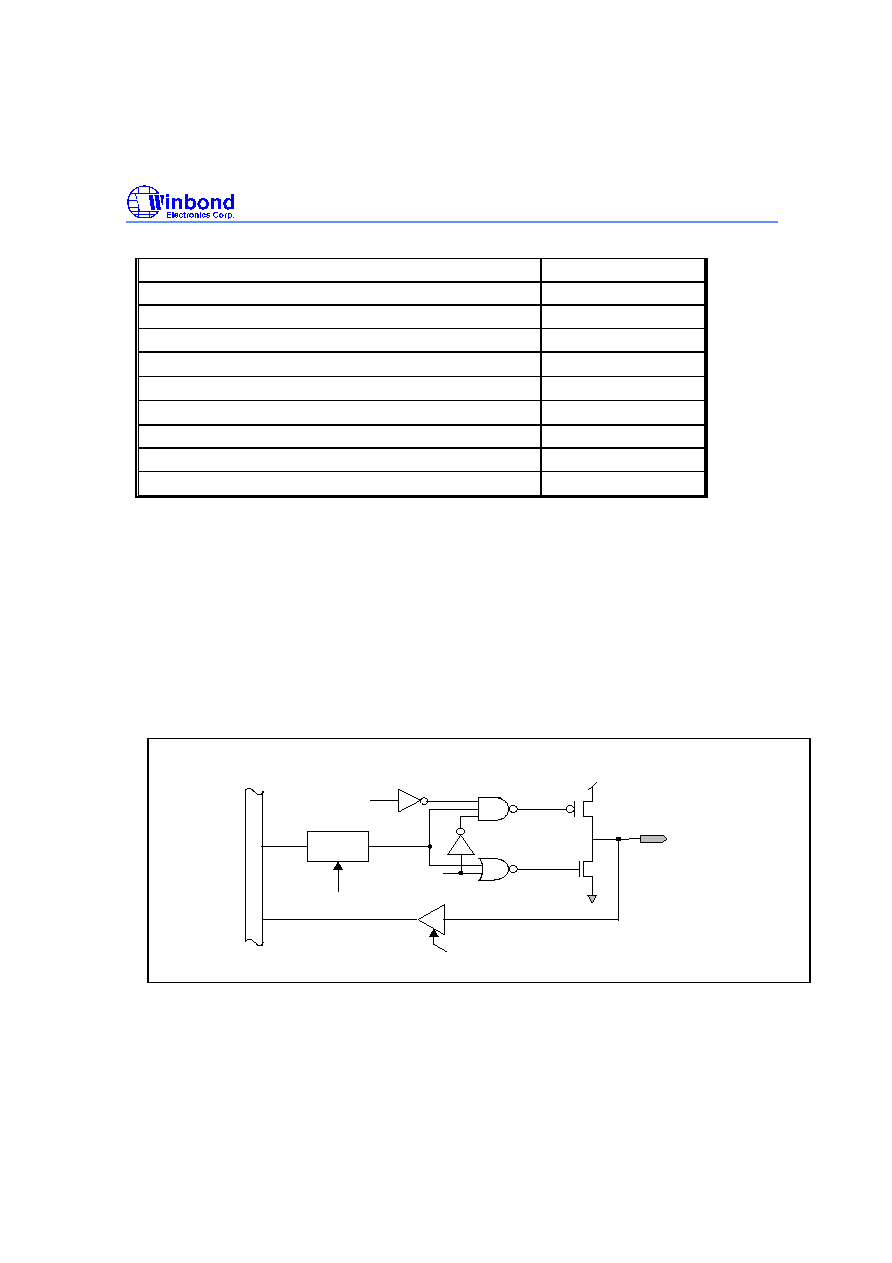
W742C818
Publication Release Date: October 2000
- 28 - Revision A2
Timer 0 input clock
F
OSC
/4
Timer 1 input clock
F
OSC
MFP output
Low
DTMF output
Hi-Z
Input/output ports RA,RB, P0
Input mode
Output port RE & RF
High
RA, RB & P0 ports output type
CMOS type
RC,RD ports pull-high resistors
Disable
Input clock of the watchdog timer
F
OSC
/1024
LCD display
OFF
Table 3 The initial state after the reset function is executed
5.17 Input/Output Ports RA, RB & P0
Port RA consists of pins RA.0 to RA.3. Port RB consists of pins RB.0 to RB.3. Port P0 consists
of pins P0.0 to P0.3. At initial reset, input/output ports RA, RB and P0 are all in input mode.
When RA and RB are used as output ports, CMOS or NMOS open drain output type can be
selected by the PM0 register. But when P0 is used as output port, the output type is always
CMOS output type. Each pin of port RA, RB and P0 can be specified as input or output mode
independently by the PM1, PM2 and PM6 registers. The MOVA R, RA or MOVA R, RB or
MOVA R, P0 instructions operate the input functions and the MOV RA, R or MOV RB, R or
MOV P0, R operate the output functions. For more detail port structure, refer to the and Figure
5-10 and Figure 5-10.
Input/Output Pin of the RA(RB)
I/O PIN
RA.n(RB.n)
DATA
BUS
Buffer
Output
PM0.0(PM0.1)
PM1.n (PM2.n)
MOVA R,RA(MOVA R,RB) instruction
MOV RA,R(MOV RB,R)
instruction
Enable
Enable
Figure 5-10 Architecture of RA (RB) Input/Output Pins
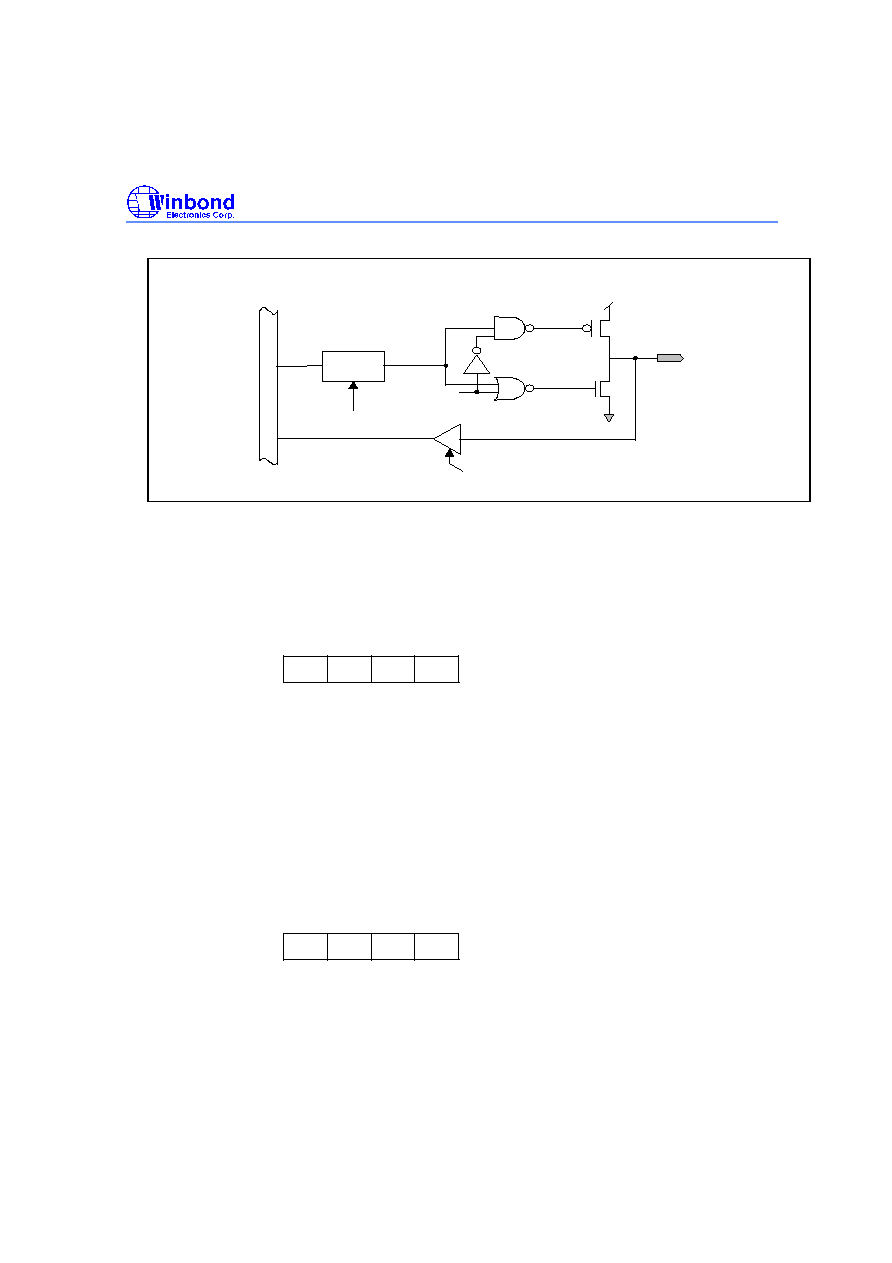
W742C818
Publication Release Date: October 2000
- 29 - Revision A2
Input/Output Pin of the P0
I/O PIN
P0.n
DATA
BUS
Buffer
Output
PM6.n
MOVA R,P0 instruction
MOV P0,R instruction
Enable
Enable
Figure 5-11 Architecture of P0 Input/Output pins
5.17.1 Port Mode 0 Register (PM0)
The port mode 0 register is organized as 4-bit binary register (PM0.0 to PM0.3). PM0 can be
used to determine the port structure; it is controlled by the MOV PM0, #I instruction. The bit
description is as follows:
PM0
w
w
w
0
1
2
w
3
Note: W means write only.
Bit 0 = 0 RA port is CMOS output type. Bit 0 = 1 RA port is NMOS open drain output type.
Bit 1 = 0 RB port is CMOS output type. Bit 1 = 1 RB port is NMOS open drain output type.
Bit 2 = 0 RC port pull-high resistor is disabled. Bit 2 = 1 RC port pull-high resistor is enabled.
Bit 3 = 0 RD port pull-high resistor is disabled. Bit 3 = 1 RD port pull-high resistor is enabled.
5.17.2 Port Mode 1 Register (PM1)
The port mode 1 register is organized as 4-bit binary register (PM1.0 to PM1.3). PM1 can be
used to control the input/output mode of port RA. PM1 is controlled by the MOV PM1, #I
instruction. The bit description is as follows:
PM1
w
w
w
0
1
2
w
3
Note: W means write only.
Bit 0 = 0 RA.0 works as output pin; Bit 0 = 1 RA.0 works as input pin
Bit 1 = 0 RA.1 works as output pin; Bit 1 = 1 RA.1 works as input pin
Bit 2 = 0 RA.2 works as output pin; Bit 2 = 1 RA.2 works as input pin
Bit 3 = 0 RA.3 works as output pin; Bit 3 = 1 RA.3 works as input pin

W742C818
Publication Release Date: October 2000
- 30 - Revision A2
At initial reset, port RA is input mode (PM1 = 1111B).
5.17.3 Port Mode 2 Register (PM2)
The port mode 2 register is organized as 4-bit binary register (PM2.0 to PM2.3). PM2 can be used
to control the input/output mode of port RB. PM2 is controlled by the MOV PM2, #I instruction. The
bit description is as follows:
PM2
w
w
w
0
1
2
w
3
Note: W means write only.
Bit 0 = 0 RB.0 works as output pin; Bit 0 = 1 RB.0 works as input pin
Bit 1 = 0 RB.1 works as output pin; Bit 1 = 1 RB.1 works as input pin
Bit 2 = 0 RB.2 works as output pin; Bit 2 = 1 RB.2 works as input pin
Bit 3 = 0 RB.3 works as output pin; Bit 3 = 1 RB.3 works as input pin
At initial reset, the port RB is input mode (PM2 = 1111B).
5.17.4 Port Mode 6 Register (PM6)
The port mode 6 register is organized as 4-bit binary register (PM6.0 to PM6.3). PM6 can be
used to control the input/output mode of port P0. PM6 is controlled by the MOV PM6, #I
instruction. The bit description is as follows:
PM6
w
w
w
0
1
2
w
3
Note: W means write only.
Bit 0 = 0 P0.0 works as output pin; Bit 0 = 1 P0.0 works as input pin
Bit 1 = 0 P0.1 works as output pin; Bit 1 = 1 P0.1 works as input pin
Bit 2 = 0 P0.2 works as output pin; Bit 2 = 1 P0.2 works as input pin
Bit 3 = 0 P0.3 works as output pin; Bit 3 = 1 P0.3 works as input pin
At initial reset, the port P0 is input mode (PM6 = 1111B).
5.18 Serial I/O interface
The bit 0 and bit 1 of port P0 can be used as a serial input/output port. P0.0 is the serial clock
I/O pin and P0.1 is the serial data I/O pin. A 4-bit binary register, Serial Interface Control
register(SIC), controls the serial port. SIC is controlled by the MOV SIC,#I instruction. The bit
definition is as follow:
SIC
w
w
w
0
1
2
w
3
=0 P0.0 & P0.1 work as normal input/output pin
Bit0
=1 P0.0 & P0.1 work as serial port function

W742C818
Publication Release Date: October 2000
- 31 - Revision A2
=0 P0.0 works as serial clock input pin
Bit1
=1 P0.0 works as serial clock output pin
=0 Serial data latched/changed at falling edge of clock
Bit2
=1 Serial data latched/changed at rising edge of clock
=0 Serial clock output frequency is fosc/2
Bit3
=1 Serial clock output frequency is fosc/256
At initial reset, SIC= 0000B.
The serial I/O functions are controlled by the instructions SOP R and SIP R. The two
instructions are described below:
(1) When in the first time the SIP R instruction is executed, the data will be loaded to
the ACC and RAM from the serial input buffer. But this data is not meaningful, it is
used to enable serial port. There are two methods to get the serial data, one is interrupt
and the other is polling. When enable the serial input, the bit 1 of port status register
2(PRS2) will automatically be set to "1" (BUSYI = 1). Then the P0.0 pin will send out 8
clocks or accept 8 clocks from external device and the data from the P0.1 pin will be
loaded to SIB buffer at the rising or falling edge of the P0.0 pin. After the 8 bits have been
received, BUSYI
will be reset to "0" and EVF.5 will be set to "1." At this time, if IEF.5 has
been set (IEF.5 = 1), an interrupt is executed then the SIP R instruction can get the correct
data from the serial input buffer(SIB), low nibble of SIB moves to ACC register and the
high nibble moves to RAM; if HEF.5 has been set (HEF.5 = 1), the hold state is
terminated. The polling method is to check the status of PSR2.1 (BUSYI) to know whether
the serial input process is completed or not. If a serial input process is not completed, but
the SIP R instruction is executed again, the data will be lost. The timing is shown in Figure
5-12.
T1
T2
T3
T4
P0.0
Data latch
BUSYI
(PSR2.1)
EVF5
Ins.
P0.1
1
2
3
4
5
6
7
8
1
2
3
4
5
6
7
8
rising latch
P0.0
falling latch
NOTE: The serial clock frequency is fosc/2
SIP R
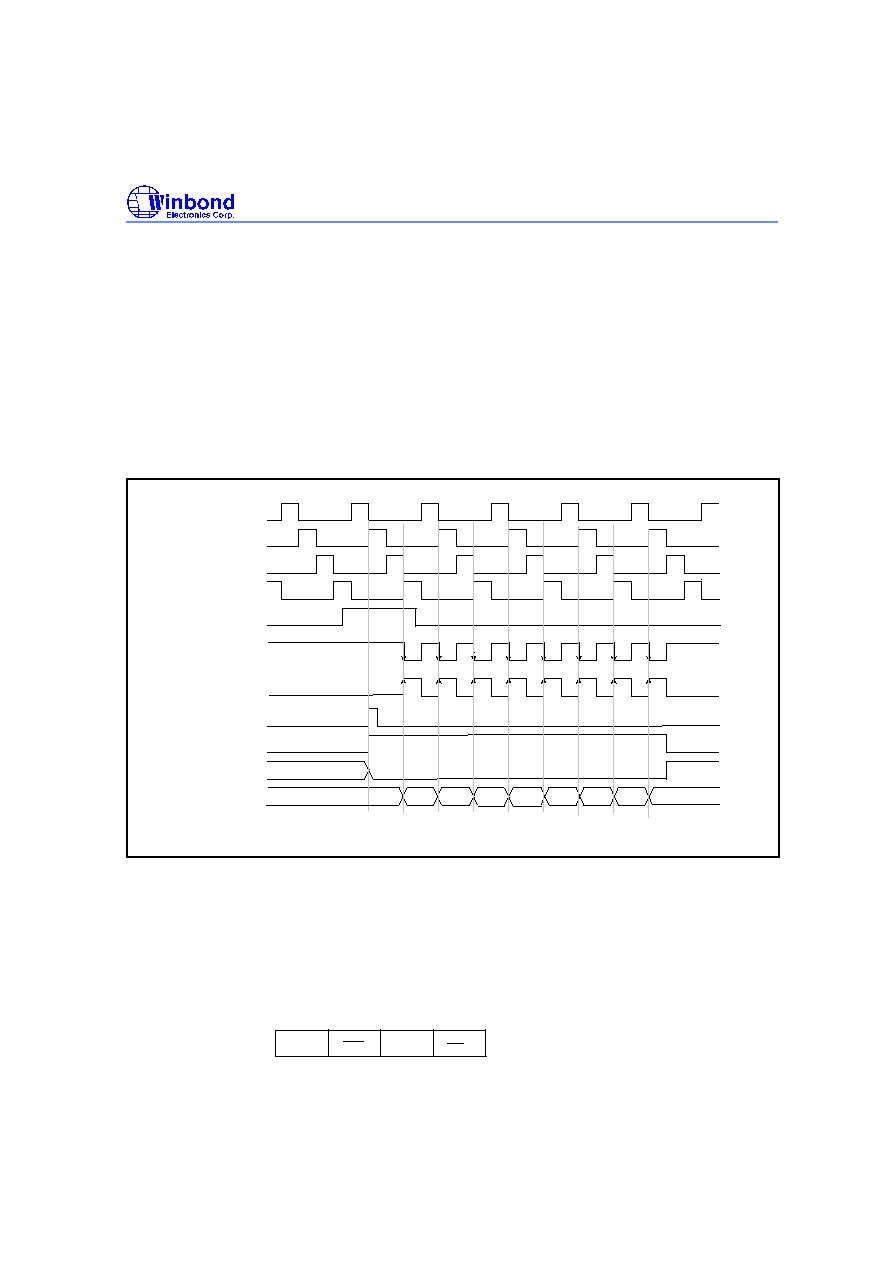
W742C818
Publication Release Date: October 2000
- 32 - Revision A2
Figure 5-12 Timing of the Serial Input Function (SIP R)
(2) When the
SOP R instruction is executed,
the data will be loaded to the serial output buffer
(SOB) from ACC and the RAM, the low nibble data of SOB is from ACC register and the
high nibble data is from RAM, and bit 3 of port status register 2(PSR2) will be set to "1"
(BUSY
O
= 1). Then the P0.0 pin will send out 8 clocks or accept 8 clocks from external
device and the data in SOB will be sent out at the rising or falling edge of the P0.1 pin.
After the 8 clocks have been sent, BUSY
O
will be reset to "0" and EVF.5 will be set to "1."
At this time, if IEF.5 has been set (IEF.5 = 1), an interrupt is executed; if HEF.5 has been
set (HEF.5 = 1), the hold state is terminated. Users can check the status of PSR2.3
(BUSYO) to know whether the serial output process is completed or not. If a serial output
process is not completed, but the SOP R instruction is executed again, the data will be
lost. The timing is shown in Figure 5-13.
T1
T2
T3
T4
P0.0
Data latch
BUSYO
(PSR2.3)
EVF5
Ins.
P0.1
1
2
3
4
5
6
7
8
1
2
3
4
5
6
7
8
data changed at falling edge
P0.0
NOTE: The serial clock frequency is fosc/2
SOP R
data changed at rising edge
Figure 5-13 Timing of the Serial Output Function (SOP R)
Port Status Register 2 (PSR2)
Port status register 2 is organized as 4-bit binary register (PSR2.0 to PSR2.3). PSR2 is
controlled by the MOVA R, PSR2, and CLR PSR2 instructions. The bit descriptions are as
follows:
R
R
0
1
2
3
PSR2

W742C818
Publication Release Date: October 2000
- 33 - Revision A2
Note: R means read only.
Bit 0 is reserved.
Bit 1 (BUSYI
):
Serial port input busy flag.
Bit 2 is reserved.
Bit 3 (BUSYO
):
Serial port output busy flag.
5.19 Input Ports RC
Port RC consists of pins RC.0 to RC.3. Each pin of port RC can be connected to an internal
pull-high resistor, which is controlled by the port mode 0 register (PM0). When the PEF, HEF,
and IEF corresponding to the RC port are set, a signal change at the specified pins of port RC
will execute the hold mode release or interrupt subroutine. Port status register 0 (PSR0)
records the status of signal changes on the pins of port RC. PSR0 can be read out and cleared
by the MOVA R, PSR0, and CLR PSR0 instructions. In addition, the falling edge signal on the
pin of port RC specified by the instruction MOV SEF, #I will cause the device to exit the stop
mode
. Refer to Figure 5-14 and the instruction table for more details.
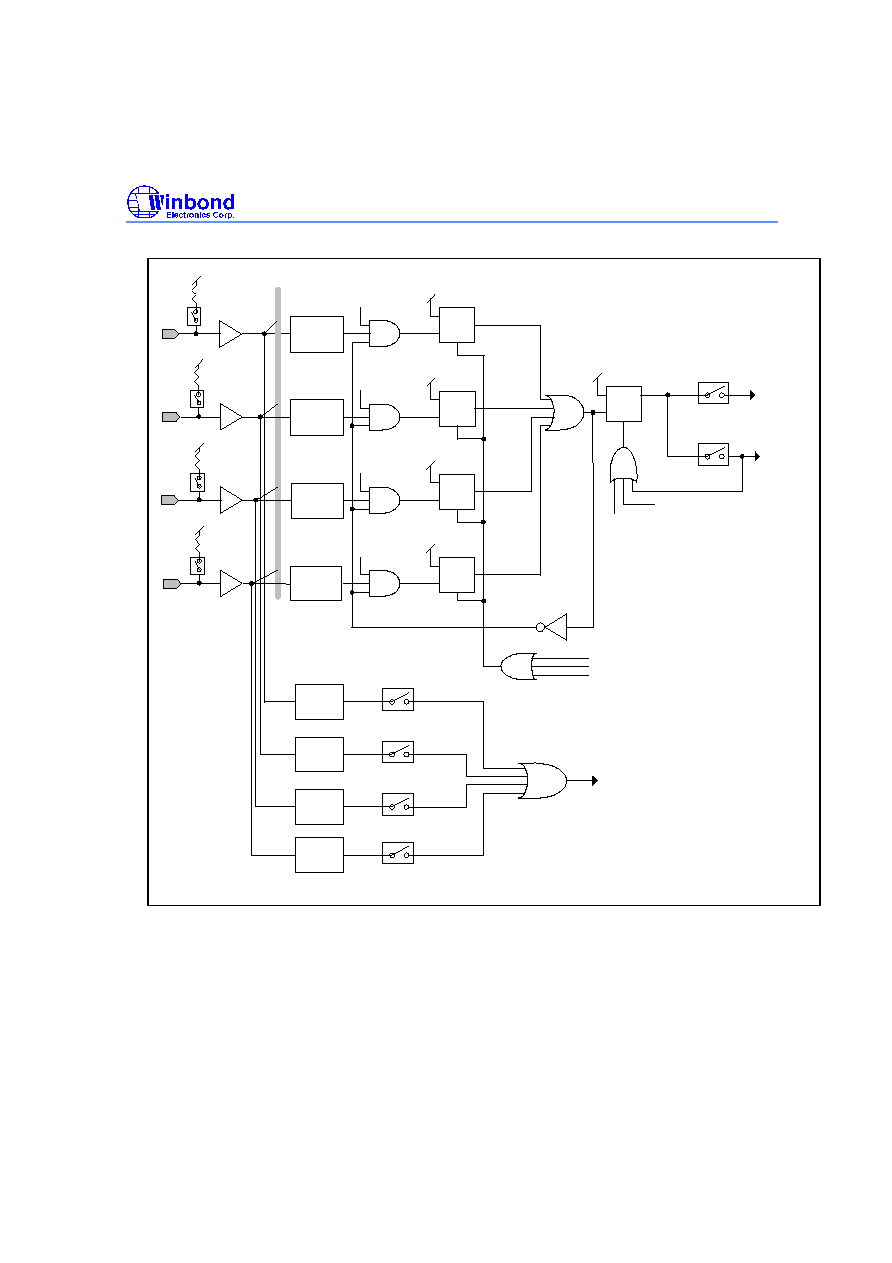
W742C818
Publication Release Date: October 2000
- 34 - Revision A2
Signal
change
detector
PEF.0
D
ck
Q
R
PSR0.0
PSR0.2
D
ck
Q
R
DATA BUS
RC.0
PSR0.3
D
ck
Q
R
PEF.3
Reset
CLR PSR0
HCF.2
INT 2
Reset
CLR EVF, #I
EVF.2
HEF.2
IEF.2
Falling
Edge
detector
Falling
Edge
detector
Falling
Edge
detector
Falling
Edge
detector
SEF.0
SEF.1
SEF.2
SEF.3
To Wake Up Stop Mode
Signal
change
detector
D
ck
Q
R
PSR0.1
RC.1
PEF.1
Signal
change
detector
D
ck
Q
R
PEF.2
RC.2
Signal
change
detector
RC.3
MOV PEF, #I
PM0.2
PM0.2
PM0.2
PM0.2
Figure 5-14 Architecture of Input Ports RC
5.19.1 Port Status Register 0 (PSR0)
Port status register 0 is organized as 4-bit binary register (PSR0.0 to PSR0.3). PSR0 can be
read or cleared by the MOVA R, PSR0, and CLR PSR0 instructions. The bit descriptions are
as follows:

W742C818
Publication Release Date: October 2000
- 35 - Revision A2
R
R
R
R
0
1
2
3
PSR0
Note: R means read only.
Bit 0 = 1 Signal change at RC.0
Bit 1 = 1 Signal change at RC.1
Bit 2 = 1 Signal change at RC.2
Bit 3 = 1 Signal change at RC.3
5.20 Input Ports RD
Port RD consists of pins RD.0 to RD.3. Each pin of port RD can be connected to a pull-high
resistor, which is controlled by the port mode 0 register (PM0). When the PEF and HEFD
corresponding to the RD port are set, a signal change at the specified pins of port RD will
execute the hold mode release. Port status register 1 (PSR1) records the status of signal
changes on the pins of port RD. PSR1 can be read out and cleared by the MOVA R, PSR1,
and CLR PSR1 instructions. In addition, the falling edge signal on the pin of port RD specified
by the instruction MOV SEF, #I will cause the device to exit the stop mode
. Refer to Figure
5-15 and the instruction table for more details.
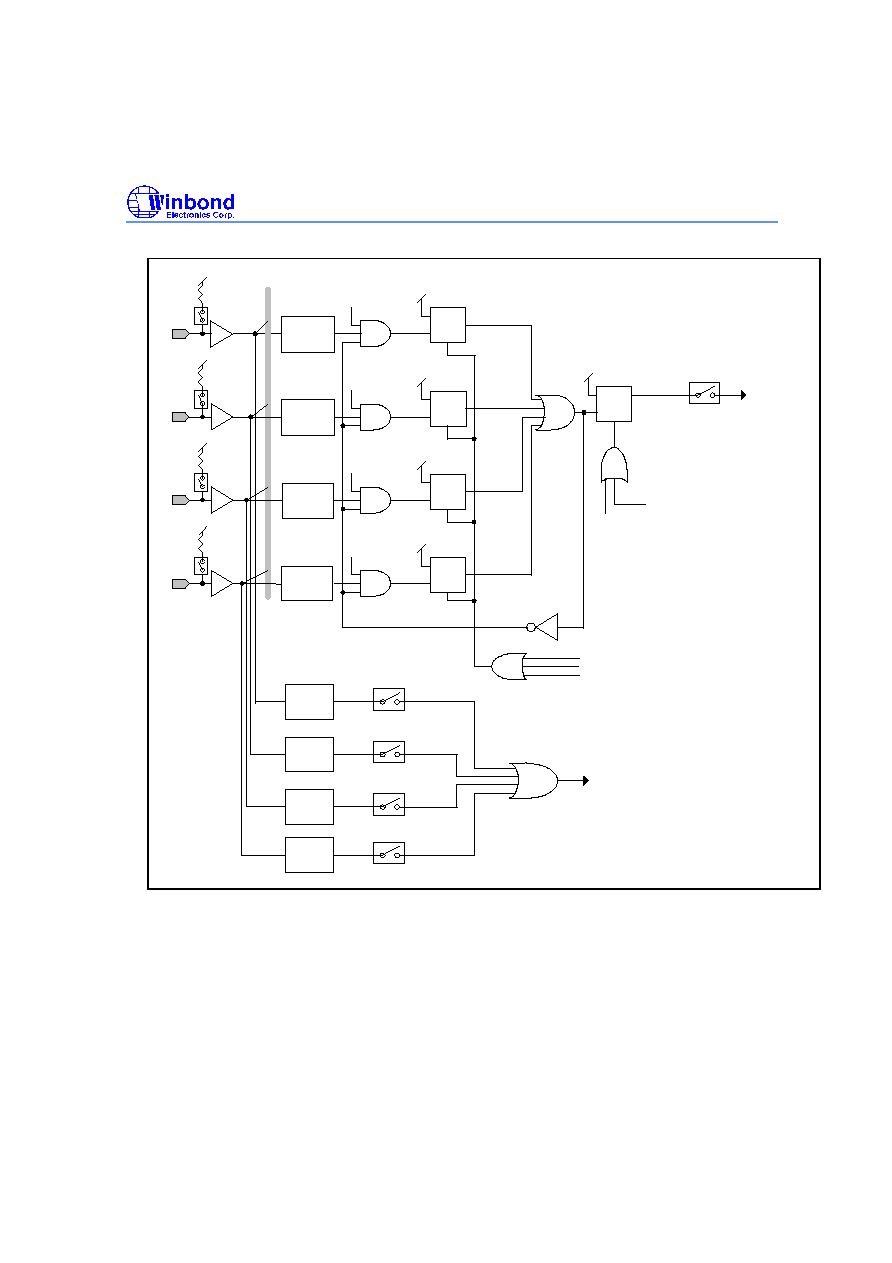
W742C818
Publication Release Date: October 2000
- 36 - Revision A2
Signal
change
detector
PEF.4
D
ck
Q
R
PSR1.0
PSR1.2
D
ck
Q
R
DATA BUS
RD.0
PSR1.3
D
ck
Q
R
PEF.7
Reset
CLR PSR1
HCFD
Reset
CLR EVFD
EVFD
HEFD
Falling
Edge
detector
Falling
Edge
detector
Falling
Edge
detector
Falling
Edge
detector
SEF.4
SEF.5
SEF.6
SEF.7
To Wake Up Stop Mode
Signal
change
detector
D
ck
Q
R
PSR1.1
RD.1
PEF.5
Signal
change
detector
D
ck
Q
R
PEF.6
RD.2
Signal
change
detector
RD.3
PM0.3
PM0.3
PM0.3
PM0.3
MOV PEF, #I
Figure 5-15 Architecture of Input Ports RD
5.20.1 Port Status Register 1 (PSR1)
Port status register 1 is organized as 4-bit binary register (PSR1.0 to PSR1.3). PSR1 can be
read or cleared by the MOVA R, PSR1, and CLR PSR1 instructions. The bit descriptions are as
follows:

W742C818
Publication Release Date: October 2000
- 37 - Revision A2
R
R
R
R
0
1
2
3
PSR1
Note: R means read only.
Bit 0 = 1 Signal change at RD.0
Bit 1 = 1 Signal change at RD.1
Bit 2 = 1 Signal change at RD.2
Bit 3 = 1 Signal change at RD.3
5.21 Output Port RE & RF
Output port RE and RF are used as output of the internal RT port. When the MOV RE, R or
MOV RF, R instruction is executed, the data in the RAM will be output to port RT through port
RE or RF. They provide high sink current to drive LED.
5.22 Input Port P1
Input port P1 is a multi-function input port. When the MOVA R, P1 instruction is executed, the
P1 data is passed to the RAM and A register. The P1.2 and P1.3 can be configured as the
external interrupt /INT0 and /INT1 by set P1EF.2 and P1EF.3.
5.23 DTMF Output Pin (DTMF)
W742C818 provides a DTMF generator which outputs the dual tone multi-frequency signal to
the DTMF pin. The DTMF generator can work well at the operating frequency of 3.58MHz. A
DTMF register specify the desired low/high frequency. And the Dual Tone Control Register
(DTCR) can control whether the dual tone will be output or not. The tones are divided into two
groups (low group and high group). The relation between the DTMF signal and the
corresponding touch tone keypad is shown in Figure 5-16
Row/Col
Frequency
R1
697 Hz
R2
770 Hz
R3
852 Hz
R4
941 Hz
C1
1209 Hz
C2
1336 Hz
C3
1477 Hz
C4
1633 Hz
Figure 5-16 The relation between the touch tone keypad and the frequency
1
2
3
A
4
5
6
B
7
8
9
C
*
0
#
D
R1
R2
R3
R4
C1
C2 C3
C4
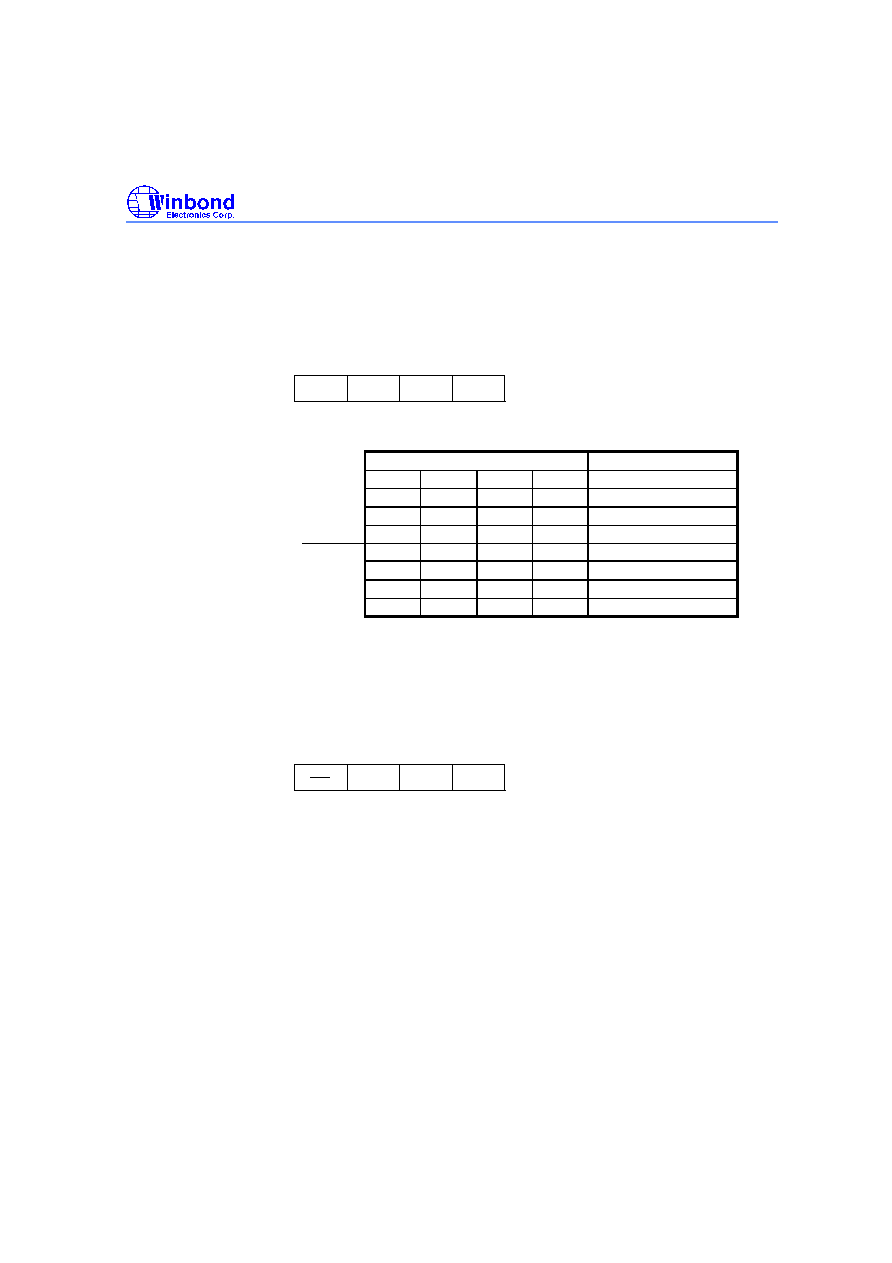
W742C818
Publication Release Date: October 2000
- 38 - Revision A2
5.23.1 DTMF register
DTMF register is organized as 4-bit binary register. By controlling the DTMF register, one tone
of the low/high group can be selected. The MOV DTMF,R instruction can specify the wanted
tones. The bit descriptions are as follows:
W
W
W
W
0
1
2
3
DTMF
Note: W means write only.
b3
b2
b1
b0
Selected tone
X
X
0
0
1209 Hz
High
X
X
0
1
1336 Hz
group
X
X
1
0
1477 Hz
(Col)
X
X
1
1
1633 Hz
0
0
X
X
697 Hz
Low
0
1
X
X
770 Hz
group
1
0
X
X
852 Hz
(Row)
1
1
X
X
941 Hz
Note: X means this bit do not care.
5.23.2 Dual Tone Control Register (DTCR)
Dual tone control register is organized as 4-bit binary register. The output of the dual or single
tone will be controlled by this register. The MOV DTCR,#I instruction can specify the wanted
status. The bit descriptions are as follows:
W
W
W
0
1
2
3
DTCR
Note: W means write only.
Bit 0 = 1 Low group tone output is enabled.
Bit 1 = 1 High group tone output is enabled.
Bit 2 = 1 DTMF output is enabled. When Bit 2 is reset to 0, the DTMF output pin will be Hi-Z
state.
Bit 3 is reserved.
5.24 MFP Output Pin (MFP)
The MFP output pin can select the output of the Timer 1 clock or the modulation frequency; the
output of the pin is determined by mode register 1 (MR1). The organization of MR1 is shown in
Figure 5-7. When bit 2 of MR1 is reset to "0," the MFP output can deliver a modulation output
in any combination of one signal from among DC, 4096Hz, 2048Hz, and one or more signals
from among 128 Hz, 64 Hz, 8 Hz, 4 Hz, 2 Hz, or 1 Hz (the clock source is from 32.768 KHz
crystal). The MOV MFP, #I instruction is used to specify the modulation output combination.
The data specified by the 8-bit operand and the MFP output pin are shown in next page.
(Fosc = 32.768 KHz)
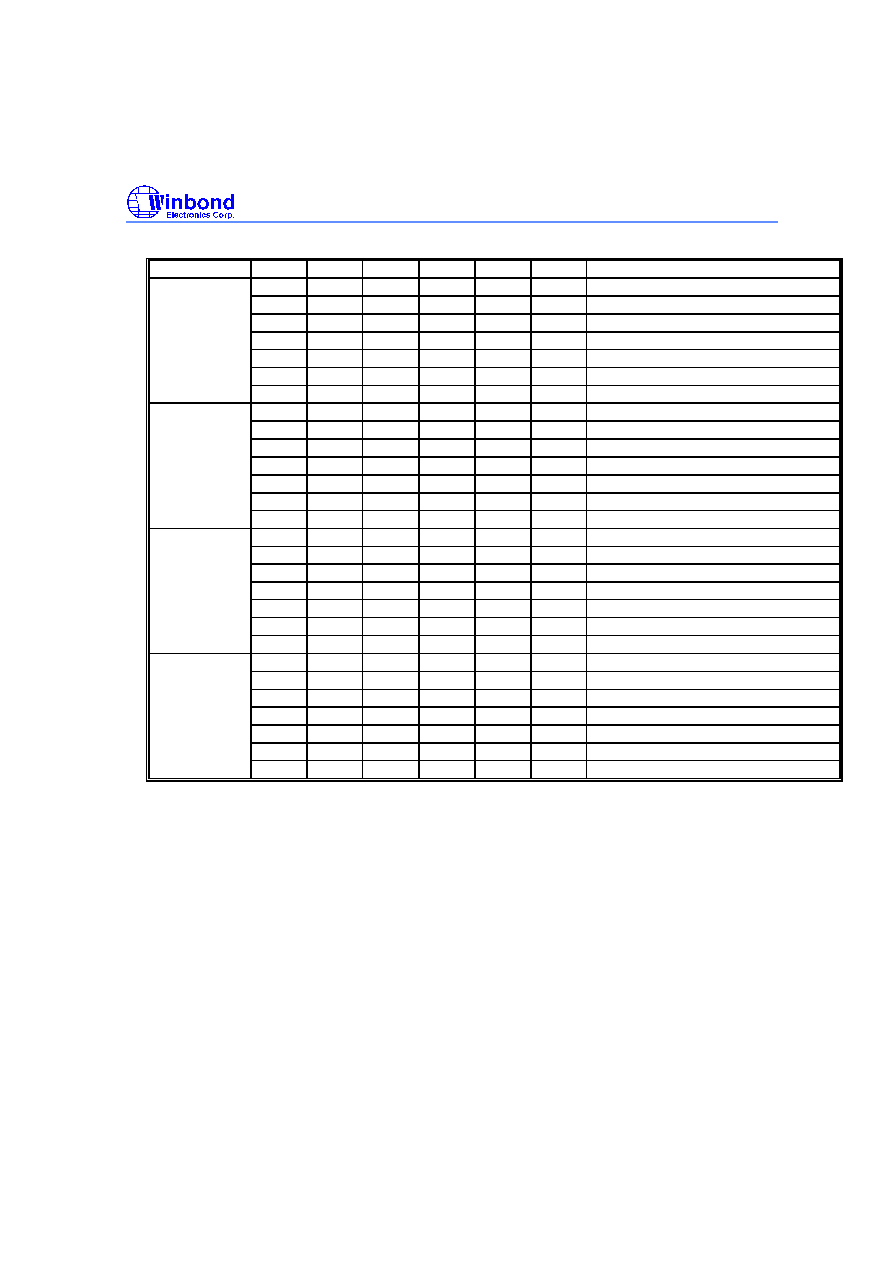
W742C818
Publication Release Date: October 2000
- 39 - Revision A2
R7 R6
R5
R4
R3
R2
R1
R0
FUNCTION
0
0
0
0
0
0
Low level
0
0
0
0
0
1
128 Hz
0
0
0
0
1
0
64 Hz
0 0
0
0
0
1
0
0
8 Hz
0
0
1
0
0
0
4 Hz
0
1
0
0
0
0
2 Hz
1
0
0
0
0
0
1 Hz
0
0
0
0
0
0
High level
0
0
0
0
0
1
128 Hz
0
0
0
0
1
0
64 Hz
0 1
0
0
0
1
0
0
8 Hz
0
0
1
0
0
0
4 Hz
0
1
0
0
0
0
2 Hz
1
0
0
0
0
0
1 Hz
0
0
0
0
0
0
2048 Hz
0
0
0
0
0
1
2048 Hz * 128 Hz
0
0
0
0
1
0
2048 Hz * 64 Hz
1 0
0
0
0
1
0
0
2048 Hz * 8 Hz
0
0
1
0
0
0
2048 Hz * 4 Hz
0
1
0
0
0
0
2048 Hz * 2 Hz
1
0
0
0
0
0
2048 Hz * 1 Hz
0
0
0
0
0
0
4096 Hz
0
0
0
0
0
1
4096 Hz * 128 Hz
0
0
0
0
1
0
4096 Hz * 64 Hz
1 1
0
0
0
1
0
0
4096 Hz * 8 Hz
0
0
1
0
0
0
4096 Hz * 4 Hz
0
1
0
0
0
0
4096 Hz * 2 Hz
1
0
0
0
0
0
4096 Hz * 1 Hz
Table 4 The relation between the MFP output frequency and the data specified by 8-bit
operand
5.25 LCD Controller/Driver
The W742C818 can directly drive an LCD with 28 segment output pins and 8 common output
pins for a total of 28 x 8 dots. The LCD driving mode is 1/8 duty and 1/3 or 1/4 bias selected by
option code. The alternating frequency of the LCD can be set as Fw/16, Fw/32, Fw/64, or
Fw/128. The structure of the LCD alternating frequency (F
LCD
) is shown in the Figure 5-17.
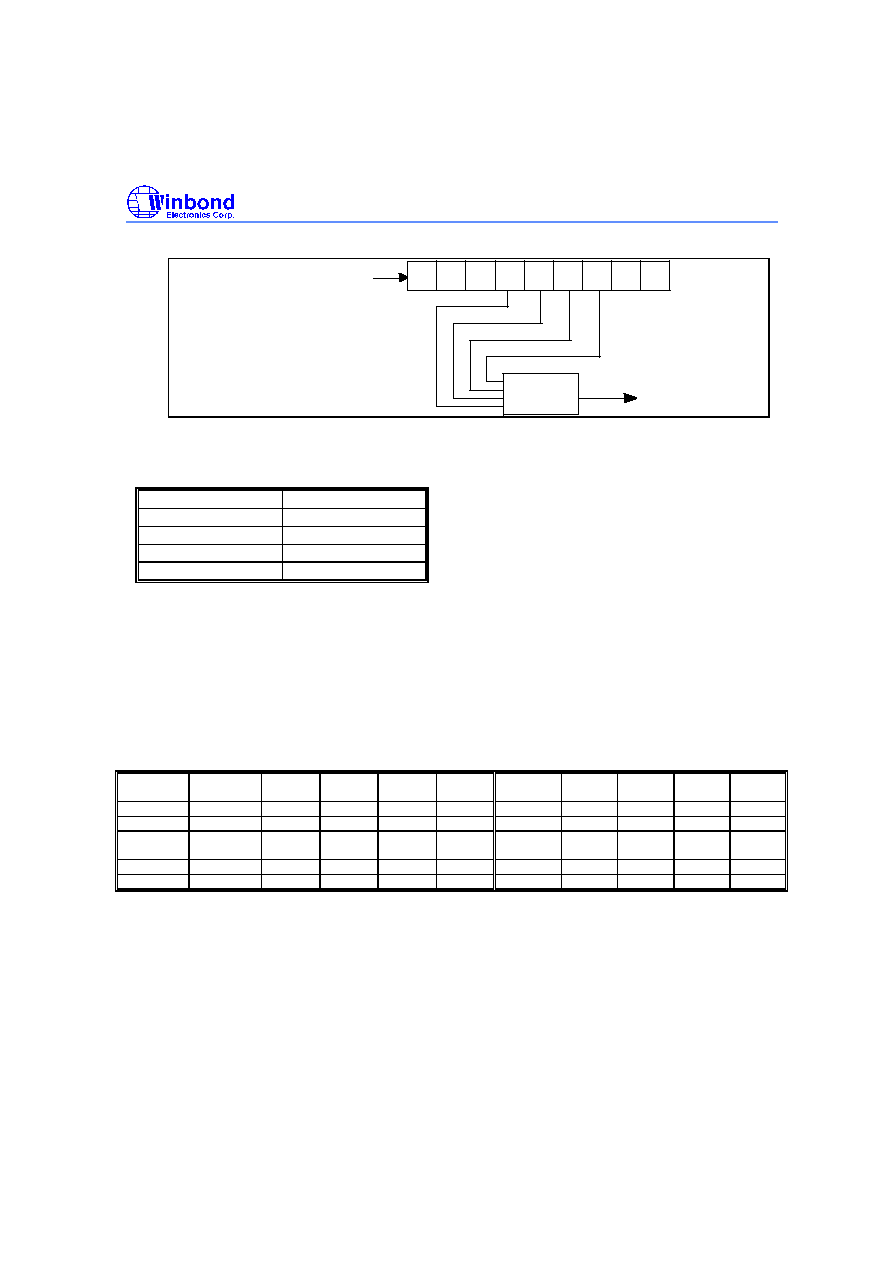
W742C818
Publication Release Date: October 2000
- 40 - Revision A2
Q1
Q2
Q3
Q4
Q5
Q6
Q7
Q8
Q9
Fw
Selector
Fw/128
Fw/64
Fw/32
Fw/16
Sub-oscillator clock
F
LCD
Figure 5-17 LCD alternating frequency (F
LCD
) circuit diagram
Fw = 32.768 KHz, the LCD frequency is as shown in the table below.
LCD Frequency
1/8 duty
Fw/128 (256 Hz)
32
Fw/64 (512 Hz)
64
Fw/32 (1024 Hz)
128
Fw/16 (2048 Hz)
256
Table 5 The relationship between the F
LCD
and the duty cycle
Corresponding to the 28 LCD drive output pins, there are 56 LCD data RAM segments.
Instructions such as MOV LPL,R, MOV LPH,R, MOV @LP,R, and MOV R,@LP are used to
control the LCD data RAM. The data in the LCD data RAM are transferred to the segment
output pins automatically without program control. When the bit value of the LCD data RAM is
"1," the LCD is turned on. When the bit value of the LCD data RAM is "0", LCD is turned off.
The contents of the LCD data RAM (LCDR) are sent out through the segment0 to segment27
pins by a direct memory access. The relation between the LCD data RAM and
segment/common pins is shown below.
OUTPUT
LCD
COM7 COM6 COM5 COM4
LCD
COM3 COM2 COM1 COM0
PIN
RAM
BIT3
BIT2
BIT1
BIT0
RAM
BIT3
BIT2
BIT1
BIT0
SEG0
LCDR01
0/1
0/1
0/1
0/1
LCDR00
0/1
0/1
0/1
0/1
SEG1
LCDR03
0/1
0/1
0/1
0/1
LCDR02
0/1
0/1
0/1
0/1
:
:
:
:
:
:
:
:
:
:
:
:
:
:
:
:
:
:
:
:
:
:
SEG26
LCDR35
0/1
0/1
0/1
0/1
LCDR34
0/1
0/1
0/1
0/1
SEG27
LCDR37
0/1
0/1
0/1
0/1
LCDR36
0/1
0/1
0/1
0/1
Table 6 The relation between the LCDR and segment/common pins
The LCDON instruction turns the LCD display on (even in HOLD mode), and the LCDOFF
instruction turns the LCD display off. At the initial reset state, the LCD display is turned off
automatically. To turn on the LCD display, the instruction LCDON must be executed.
5.25.1 LCD RAM addressing method
There are 56 LCD RAMs (LCDR00H � LCDR37H) that should be indirectly addressed. The
LCD RAM pointer (LP) is used to point to the address of the wanted LCD RAM but it is not
readable. The LP is organized as 8-bit binary register. The MOV LPL,R and MOV LPH,R
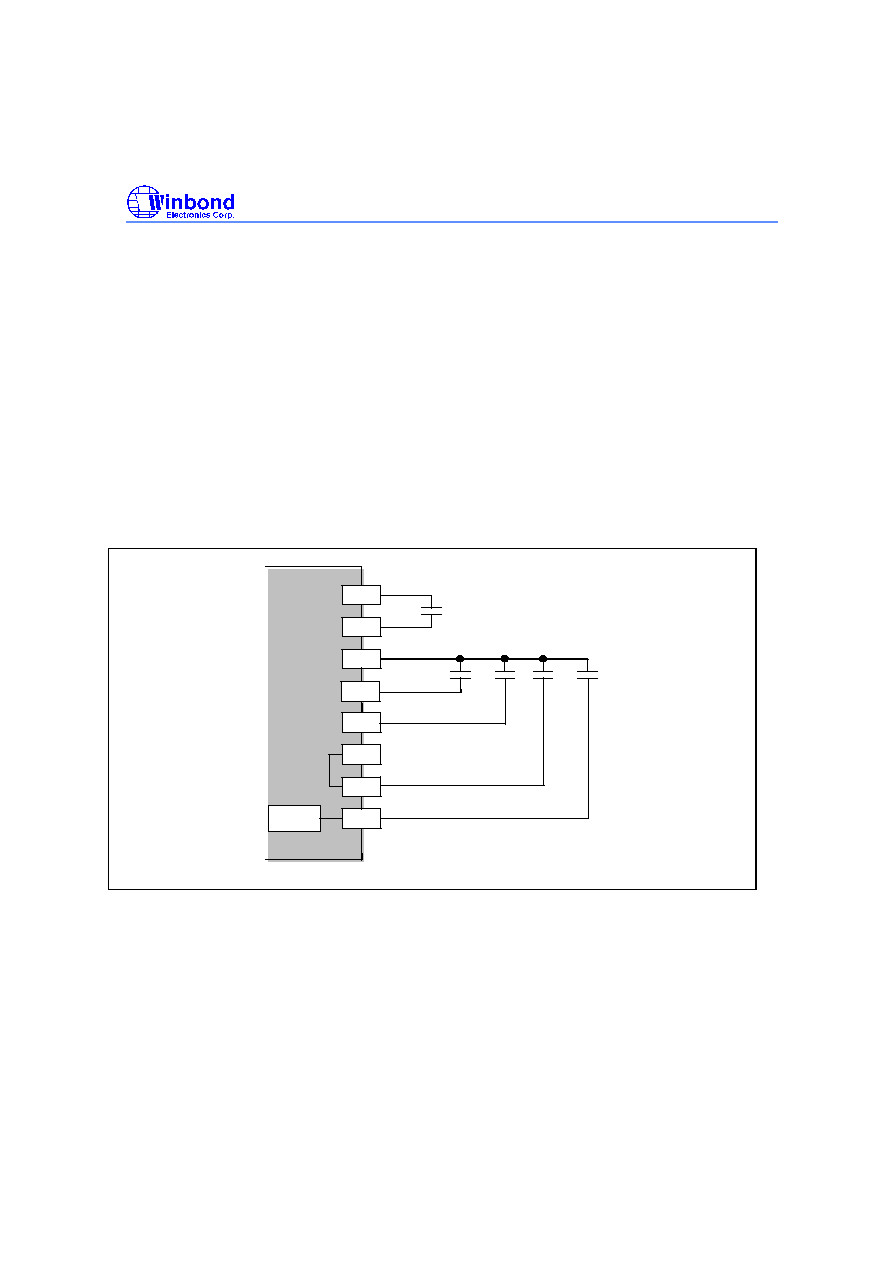
W742C818
Publication Release Date: October 2000
- 41 - Revision A2
instructions can load the LCD RAM address from RAM to the LP register. The
MOV @LP,R
and MOV R,@LP instructions can access the pointed LCD RAM content.
5.25.2 LCD voltage and contrast adjusting
An internal voltage pump is enable/disable by option code. If the voltage pump is enable, set
LCDON high to pump voltage and the signals of Com/Segment output to LCD pins according
the LCD memory, clear LCDON low to turn off the voltage pump. The voltage of internal
regulator is the base voltage of the voltage pump which pumps 3 or 4 times of the base
voltage. The output voltage of the regulator is tunable by setting LCD contrast control register
(LCDCC) by instruction MOV LCDCC,#I. When LCDCC is equal to 0AH, the output voltage is
about 1.0V. The higher value of LCDCC the lower voltage output of regulator. The adjustable
voltage range is about from 0.74V to 1.53V. Accordingly, the LCD contrast is controlled by
LCDCC register. The variation of the voltage depends on the V
DD
.
5.25.3 LCD Power Connection
The LCD power connection of bias is shown in Figure 5-18 and Figure 5-19.
CP
CN
VSS
VLCD4
VLCD3
0.1uF
0.1uF
C
H
I
P
1/4 Bias
Regulator
C3
C4
C5
C1=C2=C3=C4=C5=0.1uF
VLCD2
VLCD1
C1
C2
VLCD5
VLCD2 and VLCD3 are shorted internally
Figure 5-18 1/4 Bias LCD Power Connection

W742C818
Publication Release Date: October 2000
- 42 - Revision A2
DH1
DH2
VSS
VLCD4
VLCD3
0.1uF
0.1uF
C
H
I
P
1/3 Bias
Regulator
C3
C4
C5
C2=C3=C4=C5=0.1uF
VLCD2
VLCD1
C2
VLCD1 and VLCD2 are shorted internally
VLCD5
VLCD3 and VLCD4 are shorted internally
Figure 5-19 1/3 Bias LCD Power Connection
5.25.4 The output waveforms for the LCD driving mode
1/4 bias, 1/8 duty, A type waveform Lighting System (Example)
Normal Operating Mode
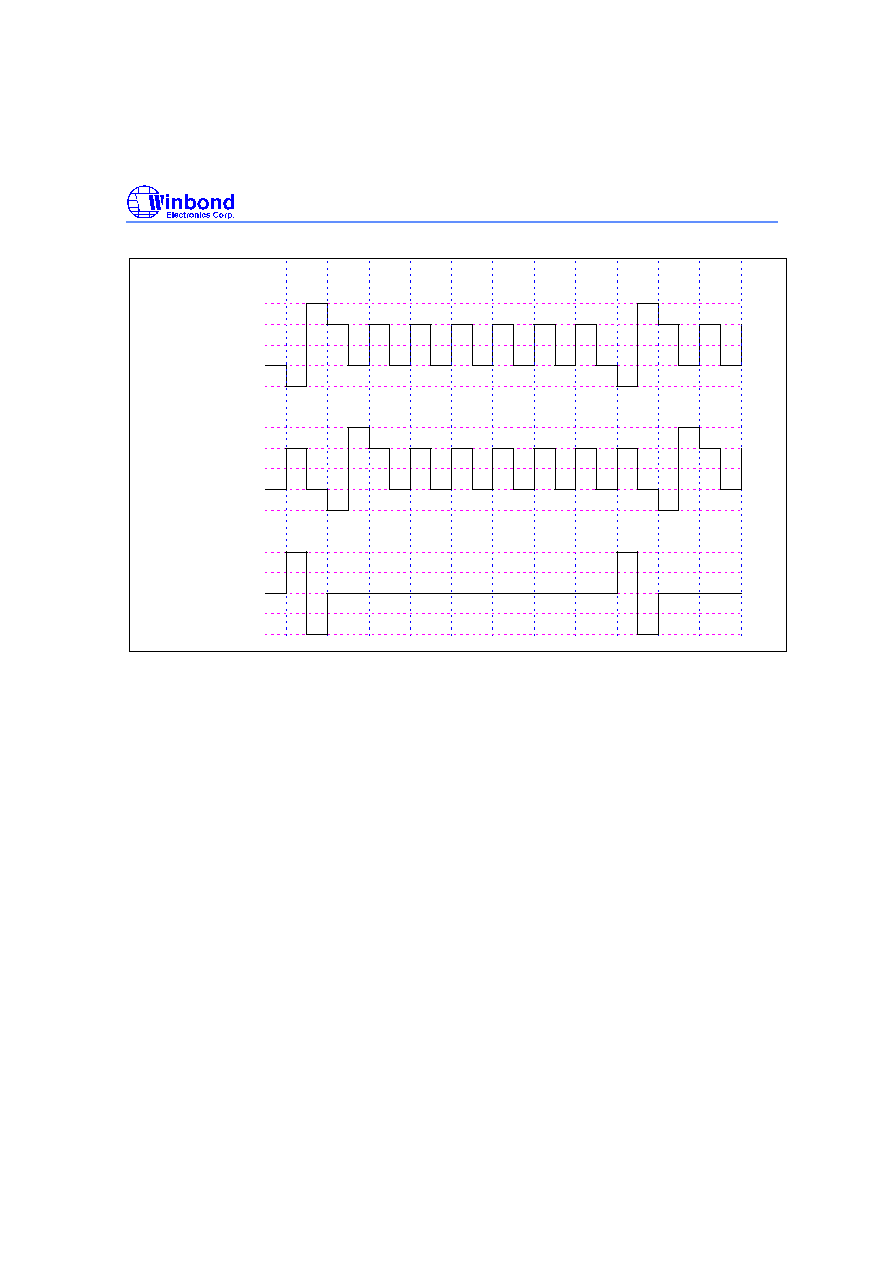
W742C818
Publication Release Date: October 2000
- 43 - Revision A2
Vss
V1
V2
V3
V4
1
2
3
4
5
6
7
8
2
3
1
Vss
V1
V2
V3
V4
COM0
LCD output for
only seg on
COM0 side
being li
Vss
V1
V2
V3
V4
COM1
Figure 5-20 1/4 bias, 1/8 duty, A type LCD waveform
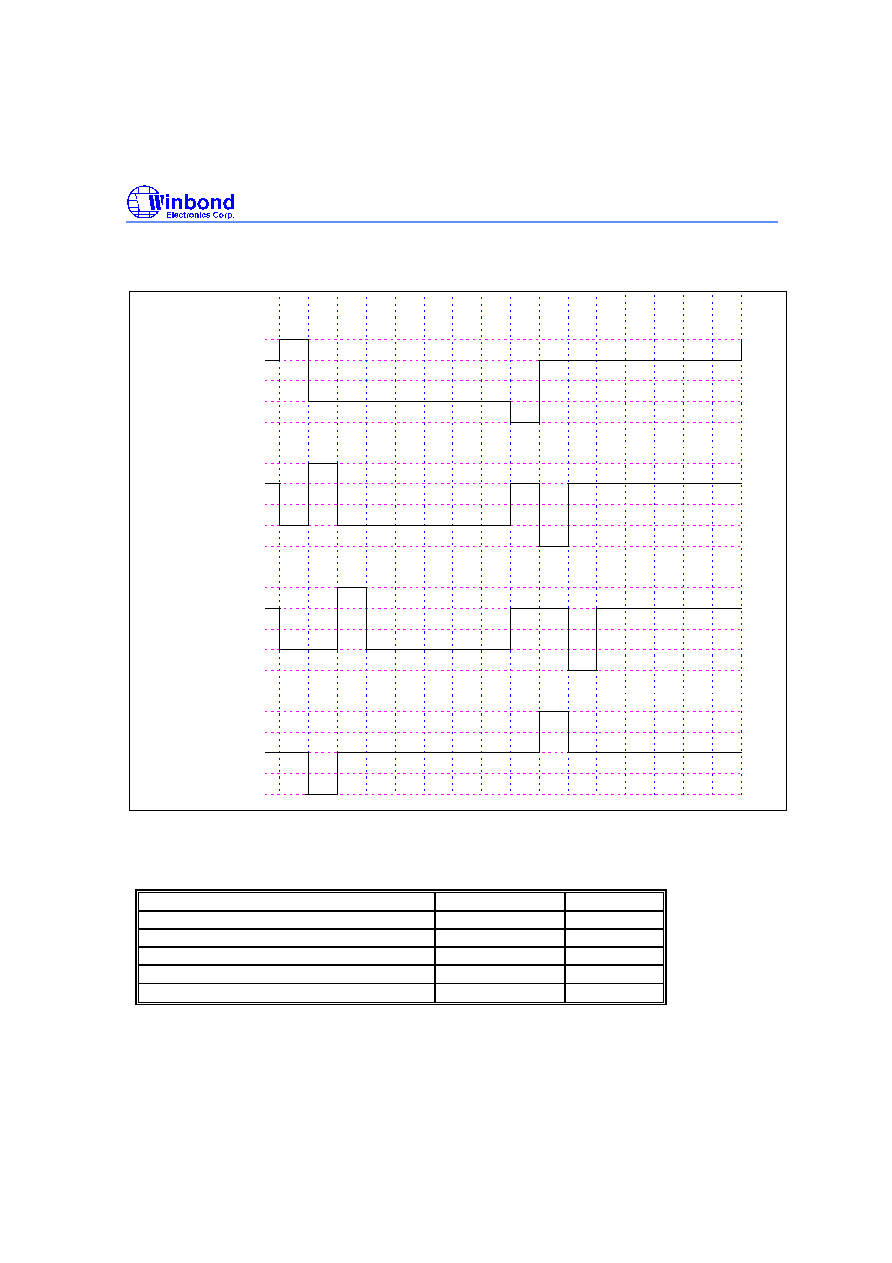
W742C818
Publication Release Date: October 2000
- 44 - Revision A2
1/4 bias, 1/8 duty, B type waveform Lighting System (Example)
Normal Operating Mode
Vss
V1
V2
V3
V4
Vss
V1
V2
V3
V4
COM0
LCD output for
only seg on
COM1 side
being li
Vss
V1
V2
V3
V4
COM1
Vss
V1
V2
V3
V4
COM1
1
2
3
4
5
6
7
8
2
3
1
4
5
6
7
8
Figure 5-21 1/4 bias, 1/8 duty, B type LCD waveform
6. ABSOLUTE MAXIMUM RATINGS
PARAMETER
RATING
UNIT
Supply Voltage to Ground Potential
-0.3 to +7.0
V
Applied Input/Output Voltage
-0.3 to +7.0
V
Power Dissipation
120
mW
Ambient Operating Temperature
0 to +70
�
C
Storage Temperature
-55 to +150
�
C
Note: Exposure to conditions beyond those listed under Absolute Maximum Ratings may adversely affect the life and reliability of
the device.

W742C818
Publication Release Date: October 2000
- 45 - Revision A2
7. DC CHARACTERISTICS
(VDD-VSS = 3.0 V, Fm = 3.58MHz, Fs = 32.768 KHz, Ta = 25
�
C, LCD on,
INTERNAL PUMP DISABLE; unless otherwise
specified)
PARAMETER
SYM
.
CONDITIONS
MIN. TYP. MAX. UNIT
OP. Voltage (W742C813)
VDD
-
2.4
-
6.0
V
Op. Voltage (W742E813)
V
DD
-
2.4
-
4.8
V
Op. Current (Crystal type)
I
OP1
No load (Ext-V)
In dual-clock normal
operation
-
0.5
1.0
mA
Op. Current (Crystal type)
I
OP3
No load (Ext-V)
In dual-clock slow
operation and Fm is
stopped
-
30
50
�
A
Hold Current (Crystal type)
I
HM1
Hold mode No load (Ext-
V)
In dual-clock normal
operation
-
400
500
�
A
Hold Current (Crystal type)
I
HM3
Hold mode No load (Ext-
V)
In dual-clock slow
operation and Fm is
stopped
-
30
50
�
A
Hold Current (Crystal type)
I
HM5
Hold mode No load (Ext-
V)
V
DD
=5V; In dual-clock
slow operation and Fm is
stopped
-
50
80
�
A
Stop Current
I
SM1
Stop mode No load (Ext-
V)
Fm and Fs are stopped
-
1
2
�
A
Input Low Voltage
V
IL
-
V
SS
-
0.3V
DD
V
Input High Voltage
V
IH
-
0.7V
DD
-
V
DD
V
MFP Output Low Voltage
V
ML
I
OL
= 3.5mA
-
-
0.4
V
MFP Output High Voltage
V
MH
I
OH
= 3.5mA
2.4
-
-
V
Port RA, RB, RD Output Low
Voltage
V
ABL
I
OL
= 2.0mA
-
-
0.4
V
Port RA, RB, RD Output High
Voltage
V
ABH
I
OH
= 2.0mA
2.4
-
-
V
LCD Supply Current
I
LCD
All Seg. ON
-
-
20
�
A
SEG0-SEG27 Sink Current
(Used as LCD output)
I
OL1
V
OL
= 0.4V
V
LCD
= 0.0V
90
-
-
�
A
SEG0-SEG27 Drive Current
(Used as LCD output)
I
OH1
V
OH
= 2.4V
V
LCD
= 3.0V
90
-
-
�
A
Port RE, RF Sink Current
I
EL
V
OL
= 0.9V
9
-
-
mA
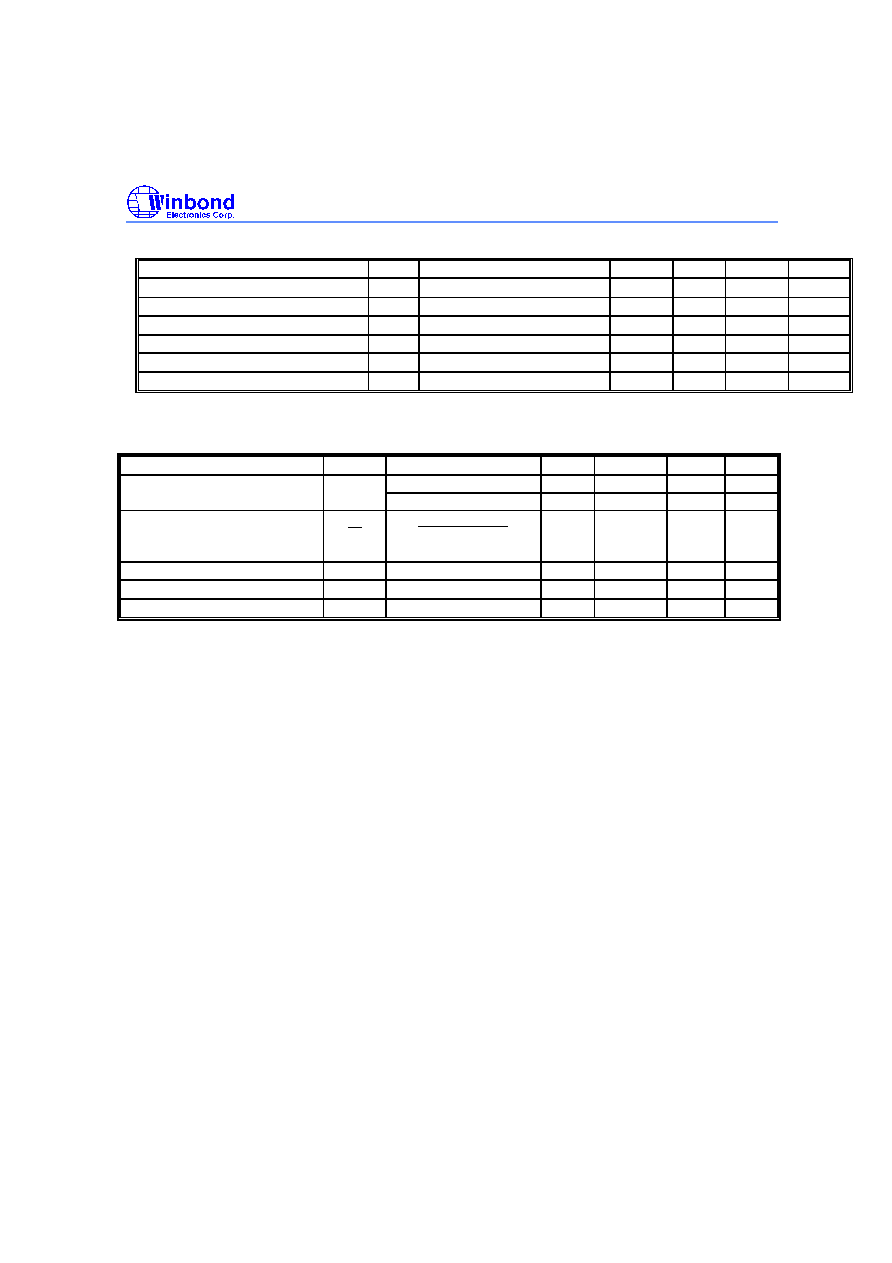
W742C818
Publication Release Date: October 2000
- 46 - Revision A2
Port RE, RF Source Current
I
EH
V
OH
= 2.4V
0.4
1.2
-
mA
DTMF Output DC level
V
TDC
R
L
=5K
, V
DD
=2.5 to 3.8V
1.1
-
2.8
V
DTMF Distortion
T
HD
R
L
=5K
, V
DD
=2.5 to 3.8V
-
-30
-23
dB
DTMF Output Voltage
V
TO
Low group, R
L
=5K
130
150
170
mVrms
Pre-emphasis
Col/Row
1
2
3
dB
Pull-up Resistor
R
C
Port RC
100
350
1000
K
RES Pull-up Resistor
R
RES
-
20
100
500
K
8. AC CHARACTERISTICS
PARAMETER
SYM. CONDITIONS
MIN.
TYP.
MAX. UNIT
Op. Frequency
F
OSC
RC type
-
2000
-
KHz
Crystal type
-
3.58
-
MHz
Frequency deviation by
voltage drop for RC
oscillator
f
f
f(3V) - f(2.4V)
f(3V)
-
-
10
%
Instruction cycle time
T
I
One machine cycle
-
4/F
OSC
-
S
Reset Active Width
T
RAW
F
OSC
=32.768 KHz
1
-
-
�
S
Interrupt Active Width
T
IAW
F
OSC
=32.768 KHz
1
-
-
�
S

W742C818
Publication Release Date: October 2000
- 47 - Revision A2
9. INSTRUCTION SET TABLE
Symbol Description
ACC:
Accumulator
ACC.n:
Accumulator bit n
WR:
Working Register
WRP:
WR Page register
PAGE:
Page Register
DBKRL:
Data Bank Register (Low nibble)
DBKRH:
Data Bank Register ( High nibble)
ROMPR:
ROM Page Register
MR0:
Mode Register 0
MR1:
Mode Register 1
PM0:
Port Mode 0
PM1:
Port Mode 1
PM4:
Port Mode 4
PM5:
Port Mode 5
PM6:
Port Mode 6
PSR0:
Port Status Register 0
PSR1:
Port Status Register 1
PSR2:
Port Status Register 2
R:
Memory (RAM) of address R
LP:
LCD data RAM pointer
LPL:
Low nibble of the LCD data RAM pointer
LPH:
High nibble of the LCD data RAM pointer
R.n:
Memory bit n of address R
I:
Constant parameter
L:
Branch or jump address
CF:
Carry Flag
ZF:
Zero Flag
PC:
Program Counter

W742C818
Publication Release Date: October 2000
- 48 - Revision A2
Continued
TM0L:
Low nibble of the Timer 0 counter
TM0H:
High nibble of the Timer 0 counter
TM1L:
Low nibble of the Timer 1 counter
TM1H:
High nibble of the Timer 1 counter
LCDCC
LCD contrast control register
TAB0:
Look-up table address buffer 0
TAB1:
Look-up table address buffer 1
TAB2:
Look-up table address buffer 2
TAB3:
Look-up table address buffer 3
IEF.n:
Interrupt Enable Flag n
HCF.n:
HOLD mode release Condition Flag n
HEF.n:
HOLD mode release Enable Flag n
HEFD:
RD port HOLD mode release Enable Flag
SEF.n:
STOP mode wake-up Enable Flag n
PEF.n:
Port Enable Flag n
P1EF.n:
P1 Port Enable Flag n
EVF.n:
Event Flag n
EVFD:
RD port Event Flag n
! =:
Not equal
&:
AND
^:
OR
EX:
Exclusive OR
:
Transfer direction, result
[PAGE*10H+()]: Contents of address PAGE(bit2, bit1, bit0)*10H+()
[P()]:
Contents of port P

W742C818
Publication Release Date: October 2000
- 49 - Revision A2
Machine code
Mnemonic
Function
Flag affected W/C
Arithmetic
0001 1000 0xxx xxxx
ADD
R, ACC
ACC
(R) + (ACC)
ZF, CF
1/1
0001 1100 i i i i nnnn
ADD
WRn, #I
ACC
(WRn) + I
ZF, CF
1/1
0001 1001 0xxx xxxx
ADDR
R, ACC
ACC, R
(R) + (ACC)
ZF, CF
1/1
0001 1101 i i i i nnnn
ADDR
WRn, #I
ACC, WRn
(WRn) + I
ZF, CF
1/1
0000 1000 0xxx xxxx
ADC
R, ACC
ACC
(R) + (ACC) + (CF)
ZF, CF
1/1
0000 1100 i i i i nnnn
ADC
WRn, #I
ACC
(WRn) + I + (CF)
ZF, CF
1/1
0000 1001 0xxx xxxx
ADCR
R, ACC
ACC, R
(R) + (ACC) + (CF)
ZF, CF
1/1
0000 1101 i i i i nnnn
ADCR
WRn, #I
ACC, WRn
(WRn) + I + (CF)
ZF, CF
1/1
0010 1000 0xxx xxxx
ADU
R, ACC
ACC
(R) + (ACC)
ZF
1/1
0010 1100 i i i i nnnn
ADU
WRn, #I
ACC
(WRn) + I
ZF
1/1
0010 1001 0xxx xxxx
ADUR
R, ACC
ACC, R
(R) + (ACC)
ZF
1/1
0010 1101 i i i i nnnn
ADUR
WRn, #I
ACC, WRn
(WRn) + I
ZF
1/1
0001 1010 0xxx xxxx
SUB
R, ACC
ACC
(R) - (ACC)
ZF, CF
1/1
0001 1110 i i i i nnnn
SUB
WRn, #I
ACC
(WRn) - I
ZF, CF
1/1
0001 1011 0xxx xxxx
SUBR
R, ACC
ACC, R
(R) - (ACC)
ZF, CF
1/1
0001 1111 i i i i nnnn
SUBR
WRn, #I
ACC, WR
(WR) - I
ZF, CF
1/1
0000 1010 0xxx xxxx
SBC
R, ACC
ACC
(R) - (ACC) - (CF)
ZF, CF
1/1
0000 1110 i i i i nnnn
SBC
WRn, #I
ACC
(WRn) - I - (CF)
ZF, CF
1/1
0000 1011 0xxxxxxx
SBCR
R, ACC
ACC, R
(R) - (ACC) - (CF)
ZF, CF
1/1
0000 1111 i i i i nnnn
SBCR
WRn, #I
ACC, WRn
(WRn) - I - (CF)
ZF, CF
1/1
0100 1010 0xxx xxxx
INC
R
ACC, R
(R) + 1
ZF, CF
1/1
0100 1010 1xxx xxxx
DEC
R
ACC, R
(R) - 1
ZF, CF
1/1
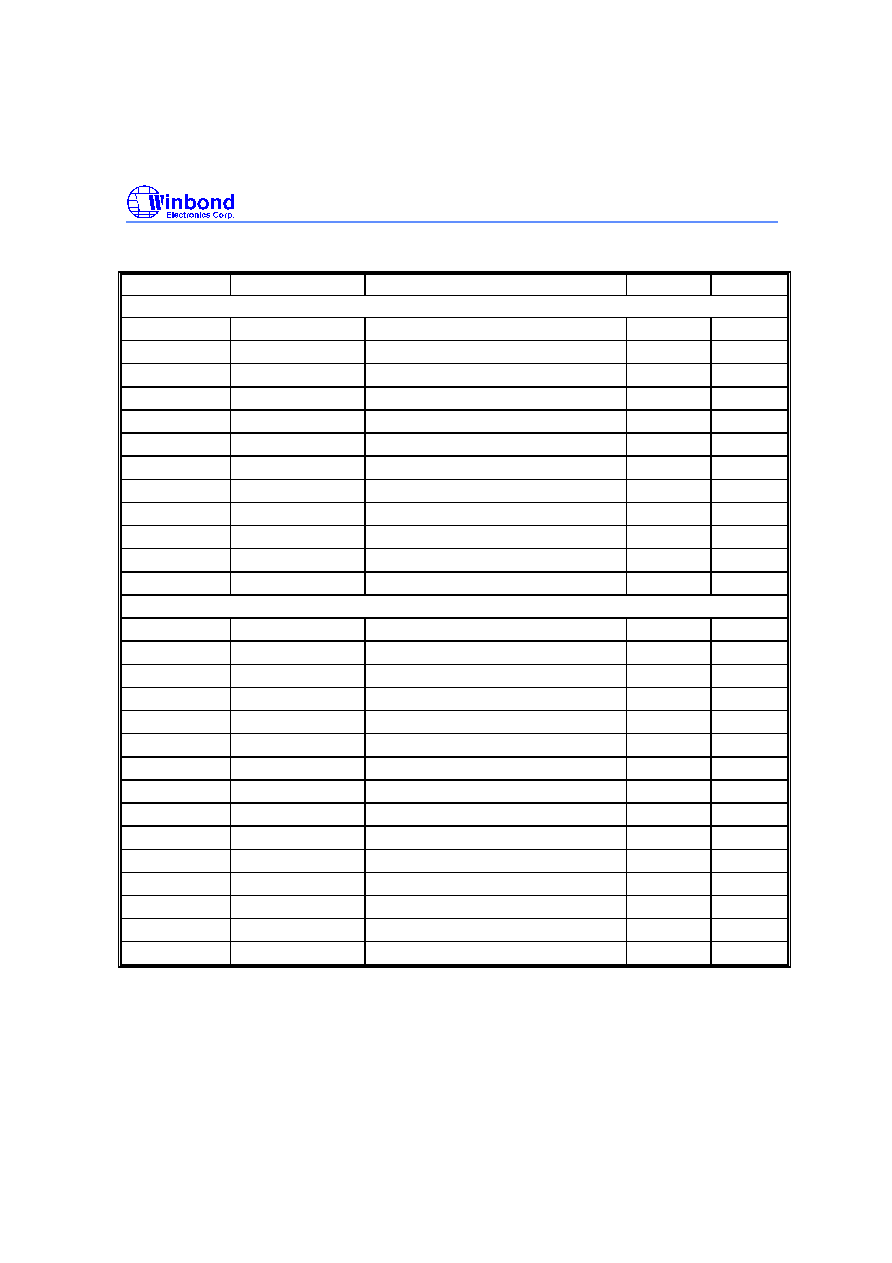
W742C818
Publication Release Date: October 2000
- 50 - Revision A2
Instruction set, continued
Machine code
Mnemonic
Function
Flag affected W/C
Logic
0010 1010 0xxx xxxx
ANL
R, ACC
ACC
(R) & (ACC)
ZF
1/1
0010 1110 i i i i nnnn
ANL
WRn, #I
ACC
(WRn) & I
ZF
1/1
0010 1011 0xxx xxxx
ANLR
R, ACC
ACC, R
(R) & (ACC)
ZF
1/1
0010 1111 i i i i nnnn
ANLR
WRn, #I
ACC, WRn
(WRn) & I
ZF
1/1
0011 1010 0xxx xxxx
ORL
R, ACC
ACC
(R)
(ACC)
ZF
1/1
0011 1110 i i i i nnnn
ORL
WRn, #I
ACC
(WRn)
I
ZF
1/1
0011 1011 0xxx xxxx
ORLR
R, ACC
ACC, R
(R)
(ACC)
ZF
1/1
0011 1111 i i i i nnnn
ORLR
WRn, #I
ACC, WRn
(WRn)
I
ZF
1/1
0011 1000 0xxx xxxx
XRL
R, ACC
ACC
(R) EX (ACC)
ZF
1/1
0011 1100 i i i i nnnn
XRL
WRn, #I
ACC
(WRn) EX I
ZF
1/1
0011 1001 0xxx xxxx
XRLR
R, ACC
ACC, R
(R) EX (ACC)
ZF
1/1
0011 1101 i i i i nnnn
XRLR
WRn, #I
ACC, WRn
(WRn) EX I
ZF
1/1
Branch
0111 0
aaa aaaa aaaa
JMP
L
PC13~PC0
(ROMPR)
�
800H+L10~L0
1/1
1000 0
aaa aaaa aaaa
JB0
L
PC10~PC0
L10~L0; if ACC.0 = "1"
1/1
1001 0
aaa aaaa aaaa
JB1
L
PC10~PC0
L10~L0; if ACC.1 = "1"
1/1
1010 0
aaa aaaa aaaa
JB2
L
PC10~PC0
L10~L0; if ACC.2 = "1"
1/1
1011 0
aaa aaaa aaaa
JB3
L
PC10~PC0
L10~L0; if ACC.3 = "1"
1/1
1110 0
aaa aaaa aaaa
JZ
L
PC10~PC0
L10~L0; if ACC = 0
1/1
1100 0
aaa aaaa aaaa
JNZ
L
PC10~PC0
L10~L0; if ACC ! = 0
1/1
1111 0
aaa aaaa aaaa
JC
L
PC10~PC0
L10~L0; if CF = "1"
1/1
1101 0
aaa aaaa aaaa
JNC
L
PC10~PC0
L10~L0; if CF != "1"
1/1
0100 1000 0xxx xxxx
DSKZ
R
ACC, R
(R) - 1; PC
(PC) + 2 if ACC = 0
ZF, CF
1/1
0100 1000 1xxx xxxx
DSKNZ R
ACC, R
(R) - 1; PC
(PC) + 2 if ACC != 0
ZF, CF
1/1
1010 1000 0xxx xxxx
SKB0
R
PC
(PC) + 2 if R.0 = "1"
1/1
1010 1000 1xxx xxxx
SKB1
R
PC
(PC) + 2 if R.1 = "1"
1/1
1010 1001 0xxx xxxx
SKB2
R
PC
(PC) + 2 if R.2 = "1"
1/1
1010 1001 1xxx xxxx
SKB3
R
PC
(PC) + 2 if R.3 = "1"
1/1
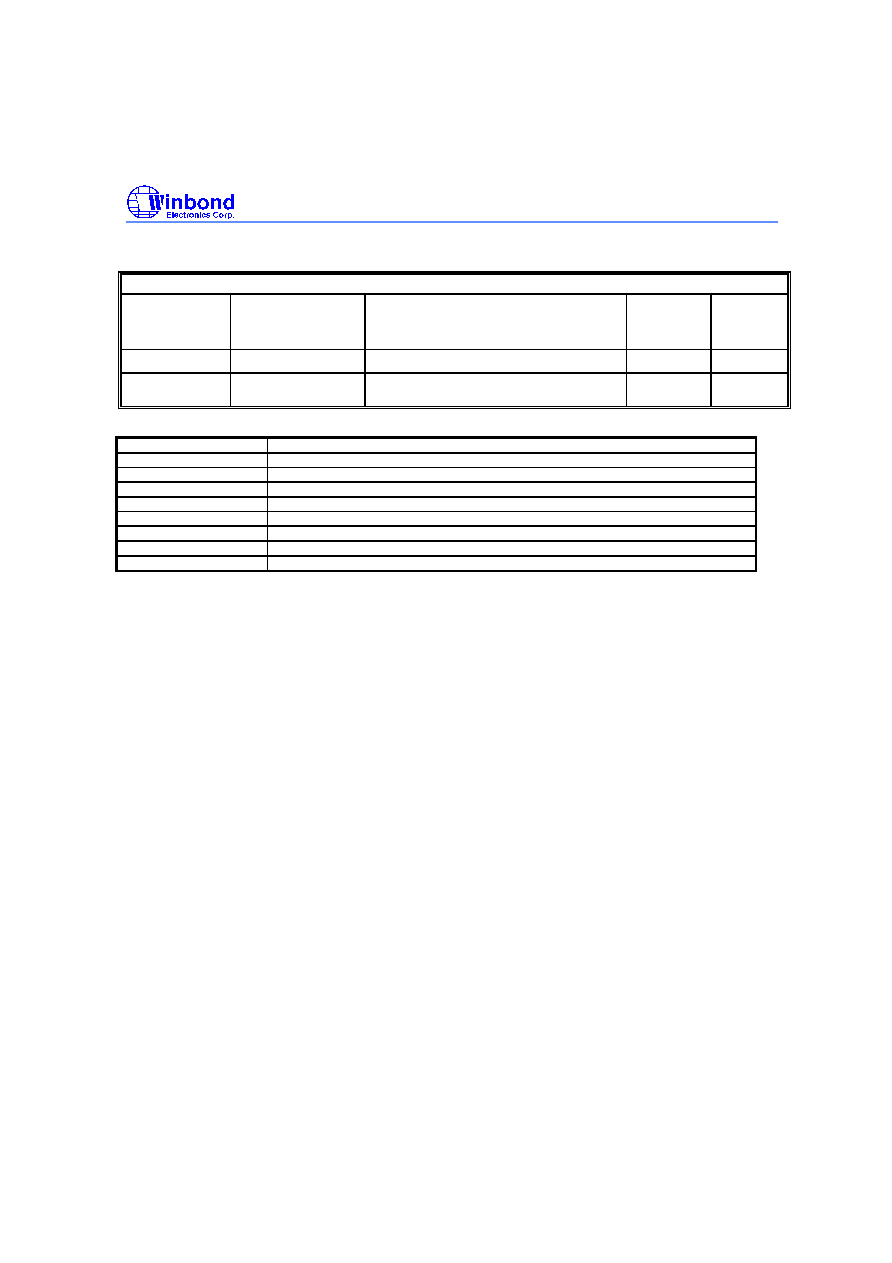
W742C818
Publication Release Date: October 2000
- 51 - Revision A2
Instruction set, continued
Subroutine
0110 0
aaa aaaa aaaa
CALL
L
STACK
(PC)+1, TAB0, TAB1, TAB2, TAB3,
DBKRL,DBKRH,WRP,ROMPR,PAGE,ACC,CF
PC13 ~ PC0
(ROMPR)
�
800H+L10 ~ L0
1/1
0000 0001 0000 0000
RTN
Pop PC
1/1
0000 0001 I I I I I I I I
RTN
# I
Pop PC; Pop other registers by I setting
refer to below table
1/1
Bit definition of I
I=0000 0000
Pop PC from stack only
bit0=1
Pop
TAB0, TAB1, TAB2, TAB3 from stack
bit1=1
Pop
DBKRL, DBKRH from stack
bit2=1
Pop
WRP from stack
bit3=1
Pop
ROMPR from stack
bit4=1
Pop
PAGE from stack
bit5=1
Pop
ACC from stack
bit6=1
Pop
CF from stack
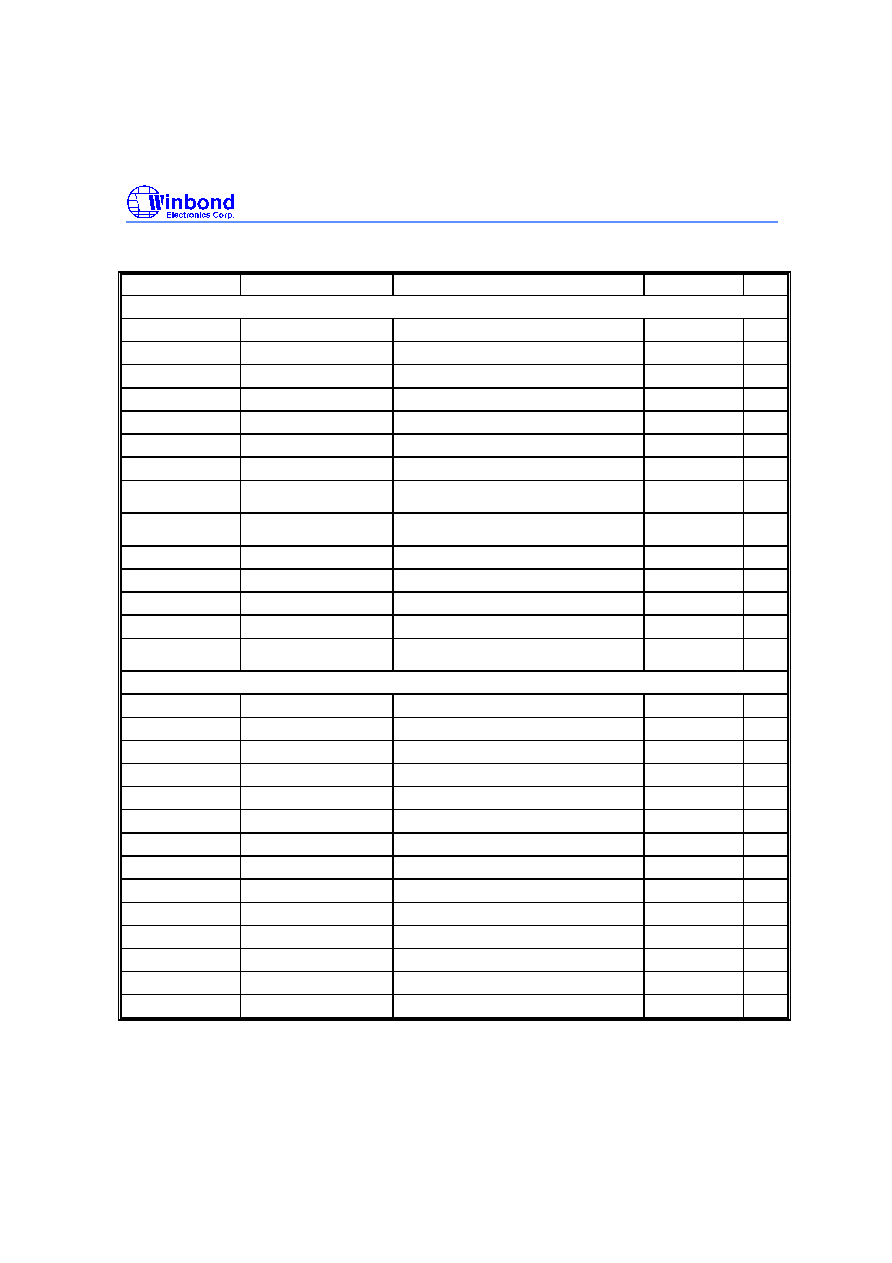
W742C818
Publication Release Date: October 2000
- 52 - Revision A2
Instruction set, continued
Machine code
Mnemonic
Function
Flag affected
W/C
Data move
1110 1nnn nxxx xxxx
MOV
WRn, R
WRn
(R)
1/1
1111 1nnn nxxx xxxx
MOV
R, WRn
R
(WRn)
1/1
0110 1nnn nxxx xxxx
MOVA
WRn, R
ACC, WRn
(R)
ZF
1/1
0111 1nnn nxxx xxxx
MOVA
R, WRn
ACC, R
(WRn)
ZF
1/1
0101 1001 1xxx xxxx
MOV
R, ACC
R
(ACC)
1/1
0100 1110 1xxx xxxx
MOV
ACC, R
ACC
(R)
ZF
1/1
1011 1 i i i i xxx xxxx
MOV
R, #I
R
I
1/1
1100 1nnn n000 qqqq
MOV
WRn, @WRq WRn
[(DBKRH)x800H+(DBKRL)
�
80H+(PA
GE)x10H +(WRq)]
1/2
1101 1nnn n000 qqqq
MOV
@WRq, WRn [(DBKRH)x800H+(DBKRL)
�
80H+(PAGE)x10
H +(WRq)]
WRn
1/2
1000 1100 0xxx xxxx
MOV
TAB0, R
TAB0
(R)
1/1
1000 1100 1xxx xxxx
MOV
TAB1, R
TAB1
(R)
1/1
1000 1110 0xxx xxxx
MOV
TAB2, R
TAB2
(R)
1/1
1000 1110 1xxx xxxx
MOV
TAB3, R
TAB3
(R)
1/1
1000 1101 0xxx xxxx
MOVC
R
R
[(TAB3)
�
1000H+(TAB2)
�
100H+(TAB1)
x10H + (TAB0)]/4
1/2
Input & Output
0101 1011 0xxx xxxx
MOVA
R, RA
ACC, R
[RA]
ZF
1/1
0101 1011 1xxx xxxx
MOVA
R, RB
ACC, R
[RB]
ZF
1/1
0100 1011 0xxx xxxx
MOVA
R, RC
ACC, R
[RC]
ZF
1/1
0100 1011 1xxx xxxx
MOVA
R, RD
ACC, R
[RD]
ZF
1/1
0101 1100 0xxx xxxx
MOVA
R, P0
ACC, R
[P0]
ZF
1/1
0101 1100 0xxx xxxx
MOVA
R, P1
ACC, R
[P1]
ZF
1/1
0101 1010 0xxx xxxx
MOV
RA, R
[RA]
(R)
1/1
0101 1010 1xxx xxxx
MOV
RB, R
[RB]
(R)
1/1
1010 1100 0xxx xxxx
MOV
RC, R
[RC]
(R)
1/1
1010 1100 1xxx xxxx
MOV
RD, R
[RD]
(R)
1/1
0101 1110 0xxx xxxx
MOV
RE, R
[RE]
(R)
1/1
1010 1110 0xxx xxxx
MOV
RF, R
[RF]
(R)
1/1
1010 1101 0xxx xxxx
MOV
P0, R
[P0]
(R)
1/1
0001 0010 i i i i i i i i
MOV
MFP, #I
[MFP]
I
1/1
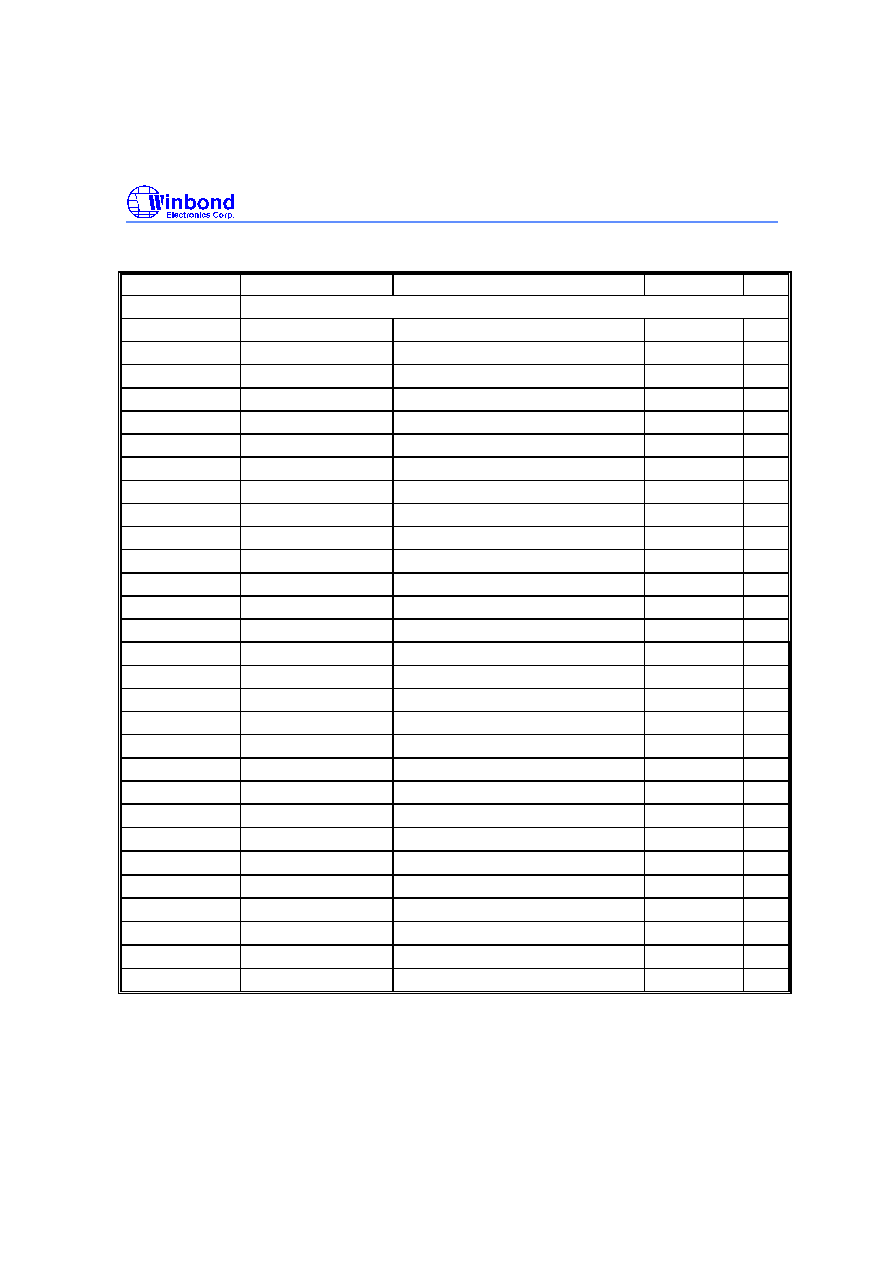
W742C818
Publication Release Date: October 2000
- 53 - Revision A2
Instruction set, continued
Machine code
Mnemonic
Function
Flag affected
W/C
Flag & Register
0101 1111 1xxx xxxx
MOVA
R, PAGE
ACC, R
PAGE (Page Register)
ZF
1/1
0101 1110 1xxx xxxx
MOV
PAGE, R
PAGE
(R)
1/1
0101 0110 1000 0i i i
MOV
PAGE, #I
PAGE
I
1/1
1001 1101 1xxx xxxx
MOV
R, WRP
R
WRP
1/1
1001 1100 1xxx xxxx
MOV
WRP, R
WRP
(R)
1/1
0011 0101 1000 i i i i
MOV
WRP, #I
WRP
I
1/1
0011 0101 0000 i i i i
MOV
DBKRL, #I
DBKRL
I
1/1
0011 0101 0100 000 i
MOV
DBKRH, #I
DBKRH
I
1/1
1001 1101 0000nnnn
MOV
WRn,DBKRL
WRn
DBKRL
1/1
1001 1101 0100nnnn
MOV
WRn,DBKRH WRn
DBKRH
1/1
1001 1100 0000nnnn
MOV
DBKRL, WRn DBKRL
WRn
1/1
1001 1100 0100nnnn
MOV
DBKRH, WRn DBKRH
WRn
1/1
0011 0100 0000 0 i i i
MOV
ROMPR, #I
ROMPR
I
1/1
1000 1000 0xxx xxxx
MOV
ROMPR, R
ROMPR
(R)
1/1
1000 1001 0xxx xxxx
MOV
R, ROMPR
R
(ROMPR)
1/1
0001 0011 1000 i 0 0 i
MOV
MR0, #I
MR0
I
1/1
0001 0011 0000 i i i i
MOV
MR1, #I
MR1
I
1/1
0101 1001 0xxx xxxx
MOVA
R, CF
ACC.0, R.0
CF
ZF
1/1
0101 1000 0xxx xxxx
MOV
CF, R
CF
(R.0)
CF
1/1
0100 1001 0xxx xxxx
MOVA
R, HCFL
ACC, R
HCF.0~HCF.3
ZF
1/1
0100 1001 1xxx xxxx
MOVA
R, HCFH
ACC, R
HCF.4~HCF.7
ZF
1/1
0101 0011 0000 i i i i
MOV
PM0, #I
Port Mode 0
I
1/1
0101 0111 0000 i i i i
MOV
PM1, #I
Port Mode 1
I
1/1
0101 0111 1000 i i i i
MOV
PM2, #I
Port Mode 2
I
1/1
0011 0111 0000 i i i i
MOV
PM4, #I
Port Mode 4
I
1/1
0011 0111 1000 i i i i
MOV
PM5, #I
Port Mode 5
I
1/1
0101 0011 1000 i i i i
MOV
PM6, #I
Port Mode 6
I
1/1
0100 0000 i 0 0 i i i i i
CLR
EVF, #I
Clear Event Flag if In = 1
1/1
0011 0000 0000 0000
CLR
EVFD
Clear RD Event Flag if In = 1
1/1
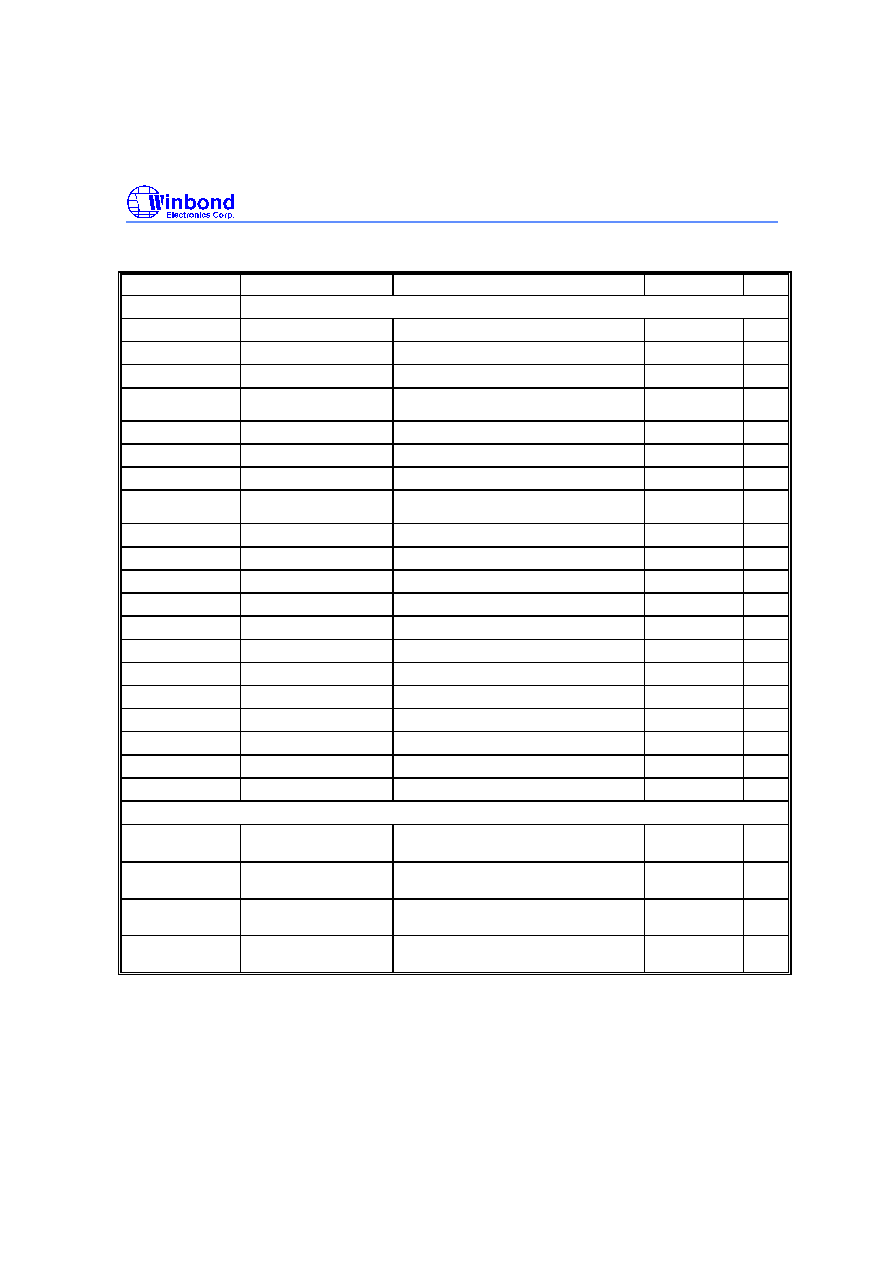
W742C818
Publication Release Date: October 2000
- 54 - Revision A2
Instruction set, continued
Machine code
Mnemonic
Function
Flag affected
W/C
Flag & Register
0101 1101 0xxx xxxx
MOVA
R, EVFL
ACC, R
EVF.0 - EVF.3
1/1
0101 1101 1xxx xxxx
MOVA
R, EVFH
ACC, R
EVF.4 - EVF.7
1/1
0100 0001 ii ii i i i i
MOV
HEF, #I
Set/Reset HOLD mode release Enable Flag
1/1
0011 0001 0000 000 i
MOV
HEFD,#I
Set/Reset RD HOLD mode release Enable
Flag
1/1
0101 0001 i i i i i i i i
MOV
IEF, #I
Set/Reset Interrupt Enable Flag
1/1
0100 0011 0000 i i i i
MOV
PEF, #I
Set/Reset Port Enable Flag
1/1
0011 0011 0000 i i 00
MOV
P1EF, #I
Set/Reset P1 Port Enable Flag
1/1
0101 0010 i i i i i i i i
MOV
SEF, #I
Set/Reset STOP mode wake-up Enable Flag
for RC,RD port
1/1
0101 0100 0000 i i i i
MOV
SCR, #I
SCR
I
1/1
0100 1111 0xxx xxxx
MOVA
R, PSR0
ACC, R
Port Status Register 0
ZF
1/1
0100 1111 1xxx xxxx
MOVA
R, PSR1
ACC, R
Port Status Register 1
ZF
1/1
0101 1111 0xxx xxxx
MOVA
R, PSR2
ACC, R
Port Status Register 2
ZF
1/1
0100 0010 0000 0000
CLR
PSR0
Clear Port Status Register 0
1/1
0100 0010 1000 0000
CLR
PSR1
Clear Port Status Register 1
1/1
0100 0010 1100 0000
CLR
PSR2
Clear Port Status Register 2
1/1
0101 0000 0100 0000
SET
CF
Set Carry Flag
CF
1/1
0101 0000 0000 0000
CLR
CF
Clear Carry Flag
CF
1/1
0001 0111 0000 0000
CLR
DIVR0
Clear the last 4-bit of the Divider 0
1/1
0101 0101 1000 0000
CLR
DIVR1
Clear the last 4-bit of the Divider 1
1/1
0001 0111 1000 0000
CLR
WDT
Clear WatchDog Timer
1/1
Shift & Rotate
0100 1101 0xxx xxxx
SHRC
R
ACC.n, R.n
(R.n+1);
ACC.3, R.3
0; CF
R.0
ZF, CF
1/1
0100 1101 1xxx xxxx
RRC
R
ACC.n, R.n
(R.n+1);
ACC.3, R.3
CF; CF
R.0
ZF, CF
1/1
0100 1100 0xxx xxxx
SHLC
R
ACC.n, R.n
(R.n-1);
ACC.0, R.0
0; CF
R.3
ZF, CF
1/1
0100 1100 1xxx xxxx
RLC
R
ACC.n, R.n
(R.n-1);
ACC.0, R.0
CF; CF
R.3
ZF, CF
1/1
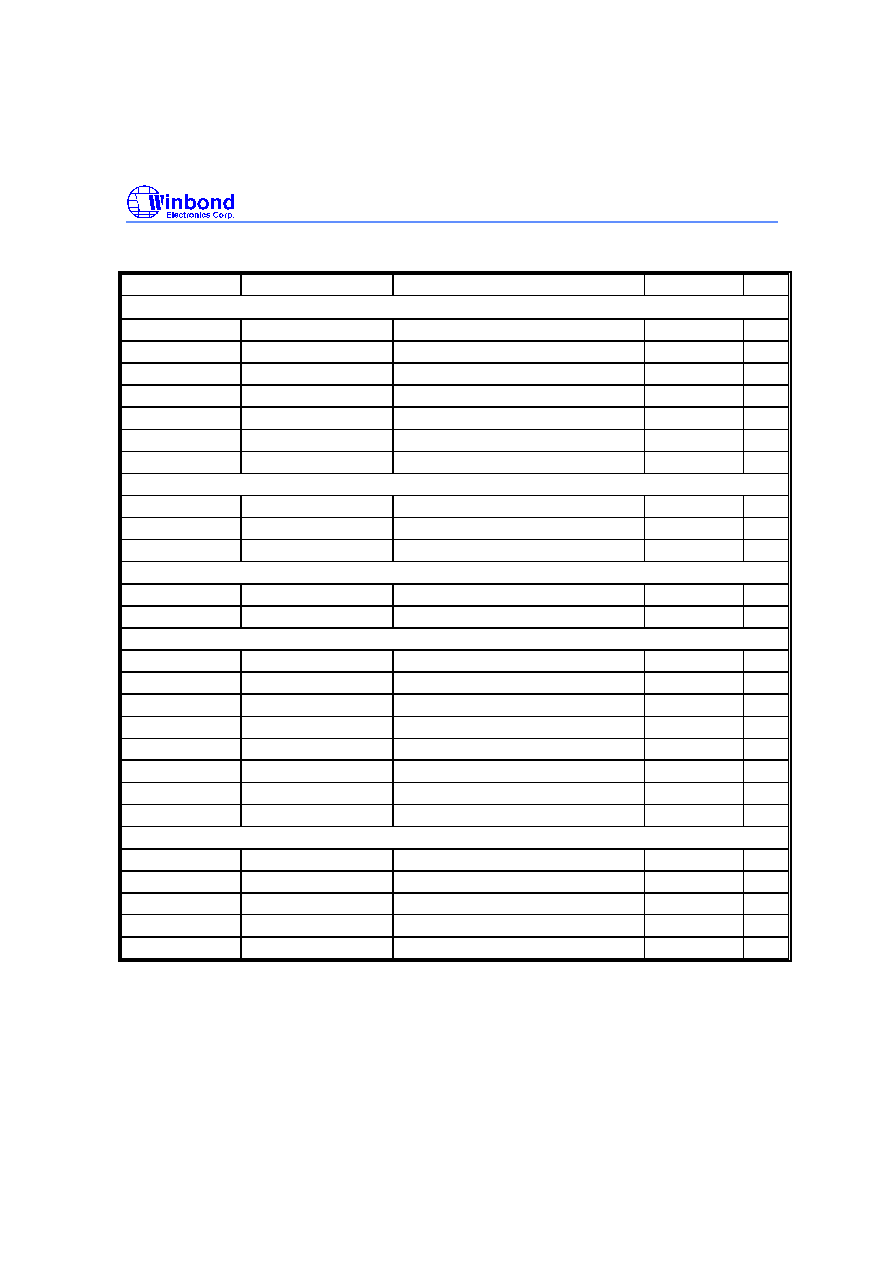
W742C818
Publication Release Date: October 2000
- 55 - Revision A2
Instruction set, continued
Machine code
Mnemonic Function
Flag affected
W/C
LCD
1001 1000 0xxx xxxx
MOV
LPL, R
LPL
(R)
1/1
1001 1000 1xxx xxxx
MOV
LPH, R
LPH
(R)
1/1
1001 1010 0xxx xxxx
MOV
@LP, R
[(LPH)
�
10H+(LPL)]
(R)
1/1
1001 1011 0xxx xxxx
MOV
R, @LP
R
[
(LPH)
�
10H+(LPL)]
1/1
0000 0010 0000 0000
LCDON
LCD ON
1/1
0000 0010 1000 0000
LCDOFF
LCD OFF
1/1
0000 0011 0000 0 i i i
MOV
LCDCC, #I
LCD contrast control
1/1
Serial I/O
0011 0010 0000 i i i i
MOV
SIC, #I
Serial Interface Control
1/1
1010 1111 0xxx xxxx
SOP
R
P0.1
R(high nibble),A(low nibble) Serially
1/1
1001 1111 0xxx xxxx
SIP
R
R(high nibble), A(low nibble)
P0.1 Serially
ZF
1/1
DTMF
0011 0100 1000 i i i i
MOV
DTCR, #I
DTMF Enable Control
1/1
1001 1110 1xxx xxxx
MOV
DTMF, R
Select DTMF frequency
1/1
Timer
1010 1010 0xxx xxxx
MOV
TM0L, R
TM0L
(R)
1/1
1010 1010 1xxx xxxx
MOV
TM0H, R
TM0H
(R)
1/1
1010 1011 0xxx xxxx
MOV
TM1L, R
TM1L
(R)
1/1
1010 1011 1xxx xxxx
MOV
TM1H, R
TM1H
(R)
1/1
1000 1111 0xxx xxxx
MOV
R, TM0L
(R)
TM0L
1/1
1000 1111 1xxx xxxx
MOV
R, TM0H
(R)
TM0H
1/1
1001 1001 0xxx xxxx
MOV
R, TM1L
(R)
TM1L
1/1
1001 1001 1xxx xxxx
MOV
R, TM1H
(R)
TM1H
1/1
Other
0000 0000 1000 0000
HOLD
Enter Hold mode
1/1
0000 0000 1100 0000
STOP
Enter Stop mode
1/1
0000 0000 0000 0000
NOP
No operation
1/1
0101 0000 1100 0000
EN
INT
Enable interrupt function
1/1
0101 0000 1000 0000
DIS
INT
Disable interrupt function
1/1

W742C818
Publication Release Date: October 2000
- 56 - Revision A2
10. PACKAGE DIMENSIONS
100L QFP(14x20x2.75mm footprint 4.8mm)
E
H
y
A
A2
Seating Plane
L
L
1
See Detail F
0.08
0
7
0
0.003
2.40
1.40
19.20
1.20
18.80
1.00
18.40
0.064
0.055
0.992
0.756
0.047
0.976
0.740
0.039
0.960
0.746
0.65
20.10
14.10
0.20
0.40
2.87
20.00
14.00
2.72
19.90
13.90
0.10
0.20
2.57
0.791
0.555
0.008
0.016
0.113
0.787
0.551
0.107
0.026
0.783
0.547
0.004
0.008
0.101
Symbol
Min
Nom
Max
Max
Nom
Min
Dimension in inch
Dimension in mm
A
b
c
D
e
H
D
H
E
L
y
A
A
L
1
1
2
E
0.012
0.006
0.15
0.30
24.40
24.80
25.20
7
0.020
0.032
0.498
0.802
0.35
0.25
0.010
0.014
0.018
0.45
Controlling dimension : Millimeters
A1
E
D
H
D
e
b
c
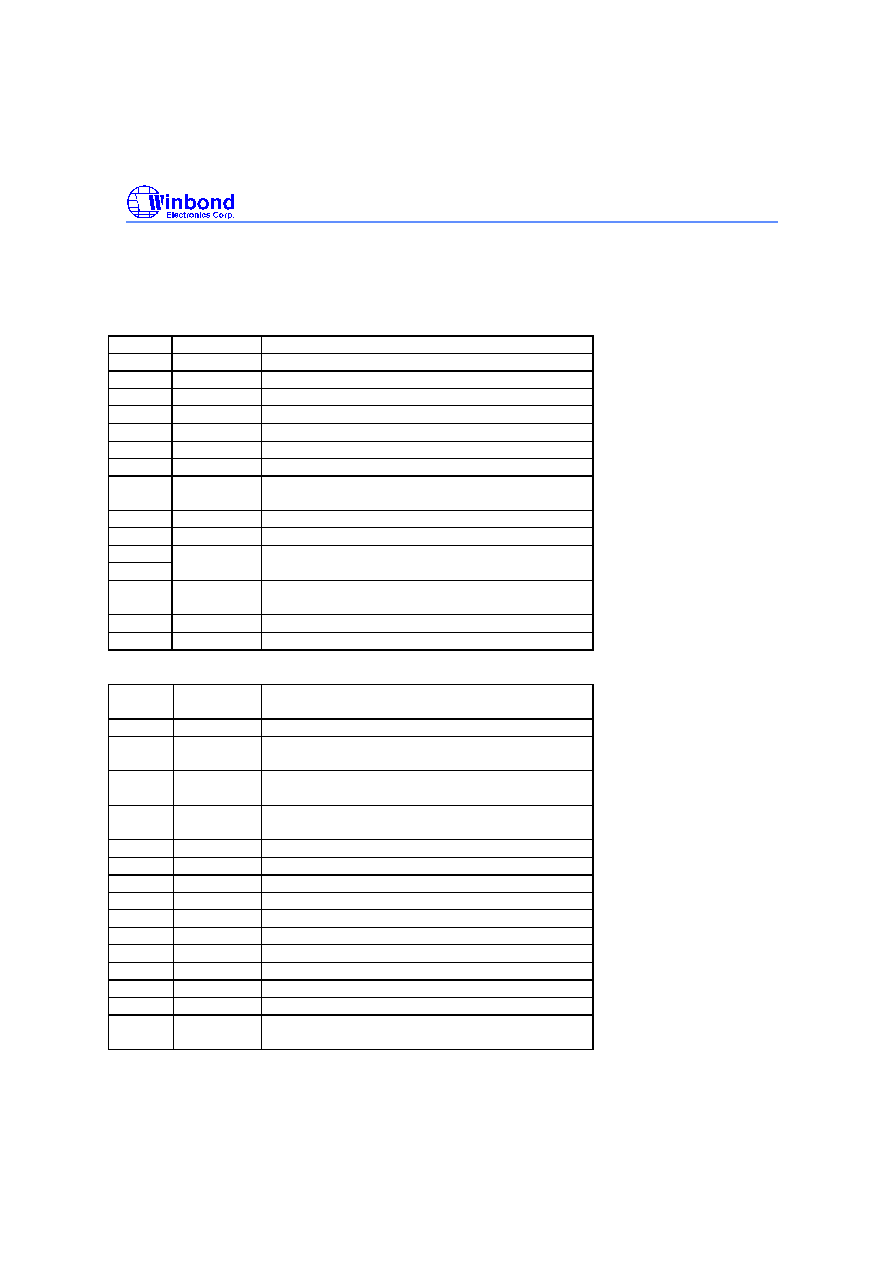
W742C818
Publication Release Date: October 2000
- 57 - Revision A2
11. Option Code Definition:
The option 1 and option 2 code are defined as following:
Option1
Bit 0
reserved
Bit 1
reserved
Bit 2
reserved
Bit 3
reserved
Bit 4
reserved
Bit 5
reserved
Bit 6
reserved
Bit 7
reserved
Bit 8
LCD bias
0: 1/4 bias;
1: 1/3 bias
Bit 9
reserved
Bit 10
reserved
Bit 11
Bit 12
F
LCD
frequency
00: Fw/16, 01: Fw/32,
10: Fw/64, 11: Fw/128
Bit 13 LCD pump 0: Enable LCD pump;
1: Disable LCD pump
Bit 14
reserved
Bit 15
reserved
Option2
Bit 0
X/R Select 0: RC;
1: Crystal
Bit 1
reserved
Bit 2
WDT En
0: Disable Watch dog timer;
1: Enable WDT
Bit 3
DTMF freq 0: 3.58MHz for DTMF;
1: 400KHz for DTMF
Bit 4
Stop delay 0: 10 level delay;
1: 15 level delay
Bit 5
reserved
Bit 6
reserved
Bit 7
reserved
Bit 8
reserved
Bit 9
reserved
Bit 10
reserved
Bit 11
reserved
Bit 12
reserved
Bit 13
reserved
Bit 14
reserved
Bit 15
LCD wave
form type
0: A type wave form;
1: B type wave form

W742C818
Publication Release Date: October 2000
- 58 - Revision A2

























































